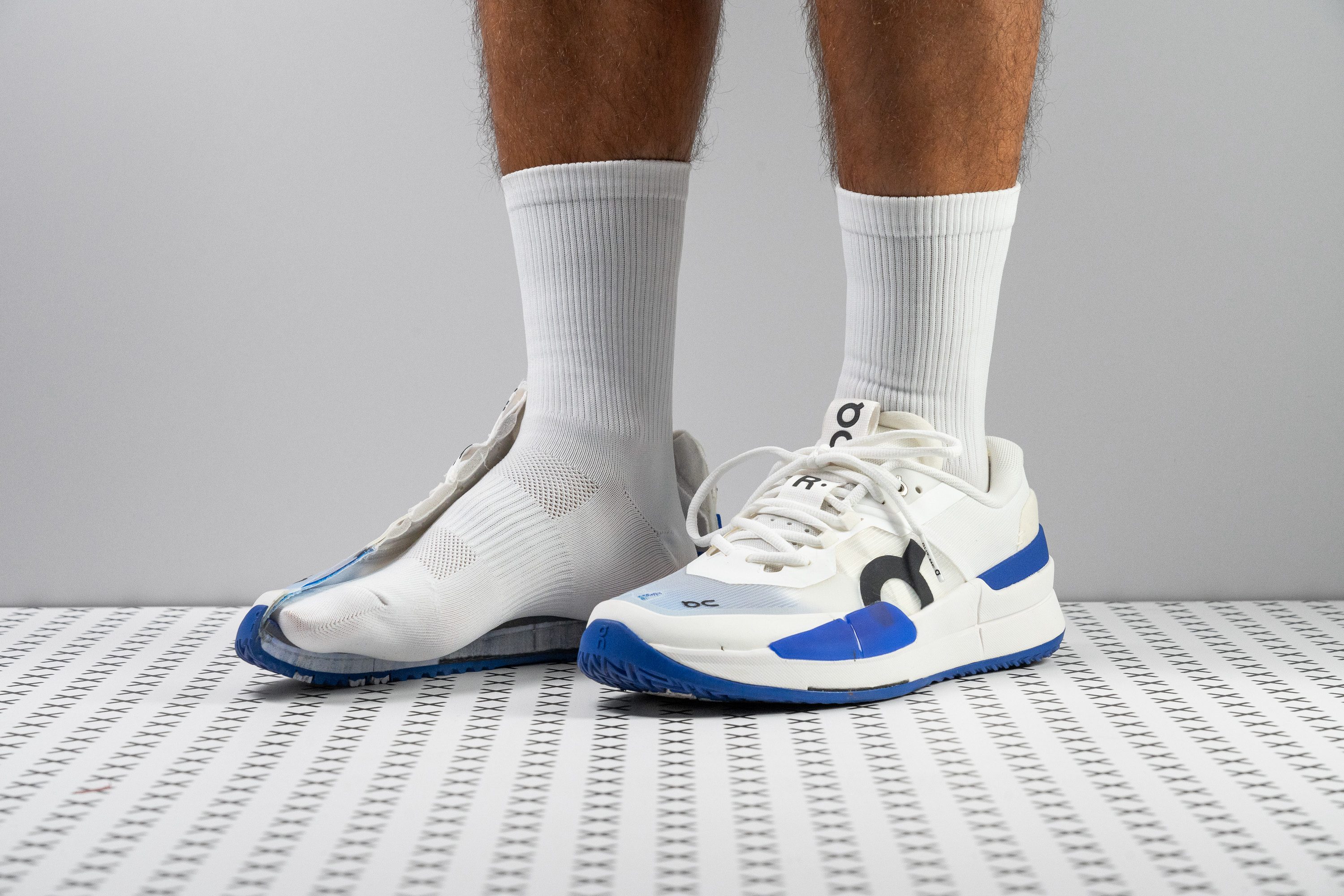Our verdict
Pros
- Exceptional support and lateral stability
- Well-connected to the court
- Very secure foothold and heel clutch
- Super strong grip on hard court
- Ultra-thin breathable upper
- True to size
Cons
- Poor upper and toe guard durability
- Heavier than average
- Overpriced
Audience verdict
Comparison
The most similar tennis shoes compared
+ + Add a shoe | |||||
|---|---|---|---|---|---|
| Audience score | 77 Decent! | 62 Bad! | 84 Good! | 83 Good! | |
| Price | $200 | $135 | $170 | $160 | |
| Shoe type | Hard Court | Hard Court | Hard Court | All CourtHard Court | |
| Shock absorption | Low | - | Moderate | Moderate | |
| Energy return | Low | - | Low | Moderate | |
| Traction | Moderate | - | - | Moderate | |
| Construction | Speed | Speed | Stability | Stability | |
| Breathability | Breathable | Breathable | Moderate | Moderate | |
| Weight lab | 14.4 oz / 407g | 13.8 oz / 390g | 14.3 oz / 406g | 14.7 oz / 417g | |
| Drop lab | 9.1 mm | 8.4 mm | 10.4 mm | 7.5 mm | |
| Width / fit | Medium | Wide | Medium | Wide | |
| Toebox width | Medium | Wide | Narrow | Medium | |
| Size | Slightly small | Slightly small | True to size | Half size small | |
| Midsole softness | Firm | Balanced | Firm | Firm | |
| Stiffness | Stiff | Stiff | Stiff | Moderate | |
| Torsional rigidity | Stiff | Stiff | Stiff | Stiff | |
| Heel counter stiffness | Moderate | Moderate | Moderate | Moderate | |
| Midsole width - forefoot | Wide | Wide | Wide | Average | |
| Midsole width - heel | Average | Average | Average | Average | |
| Outsole durability | Decent | Decent | Good | Good | |
| Heel padding durability | Decent | Bad | Bad | Decent | |
| Collaboration | Roger Federer | - | Novak Djokovic | - | |
| Heel stack lab | 29.2 mm | 29.8 mm | 32.2 mm | 30.0 mm | |
| Forefoot | 20.1 mm | 21.4 mm | 21.8 mm | 22.5 mm | |
| Insole thickness | Average | Average | Average | Average | |
| Removable insole | ✓ | ✓ | ✓ | ✓ | |
| Heel tab | None | None | None | None | |
| Toebox durability | Bad | Decent | Good | Decent | |
| Outsole hardness | Average | Hard | Average | Average | |
| Outsole thickness | Average | Average | Thin | Average | |
| Ranking | #36 Bottom 7% | #39 Bottom 1% | #20 Bottom 48% | #26 Bottom 33% | |
| Popularity | #23 Bottom 41% | #36 Bottom 7% | #2 Top 6% | #15 Top 39% |
Who should buy
Incorporating feedback from Roger Federer, the On Roger Pro 2 was designed for advanced players who look for the following:
- a highly stable and supportive shoe without large and clunky sidewalls
- a shoe in which court feel dominates cushioning
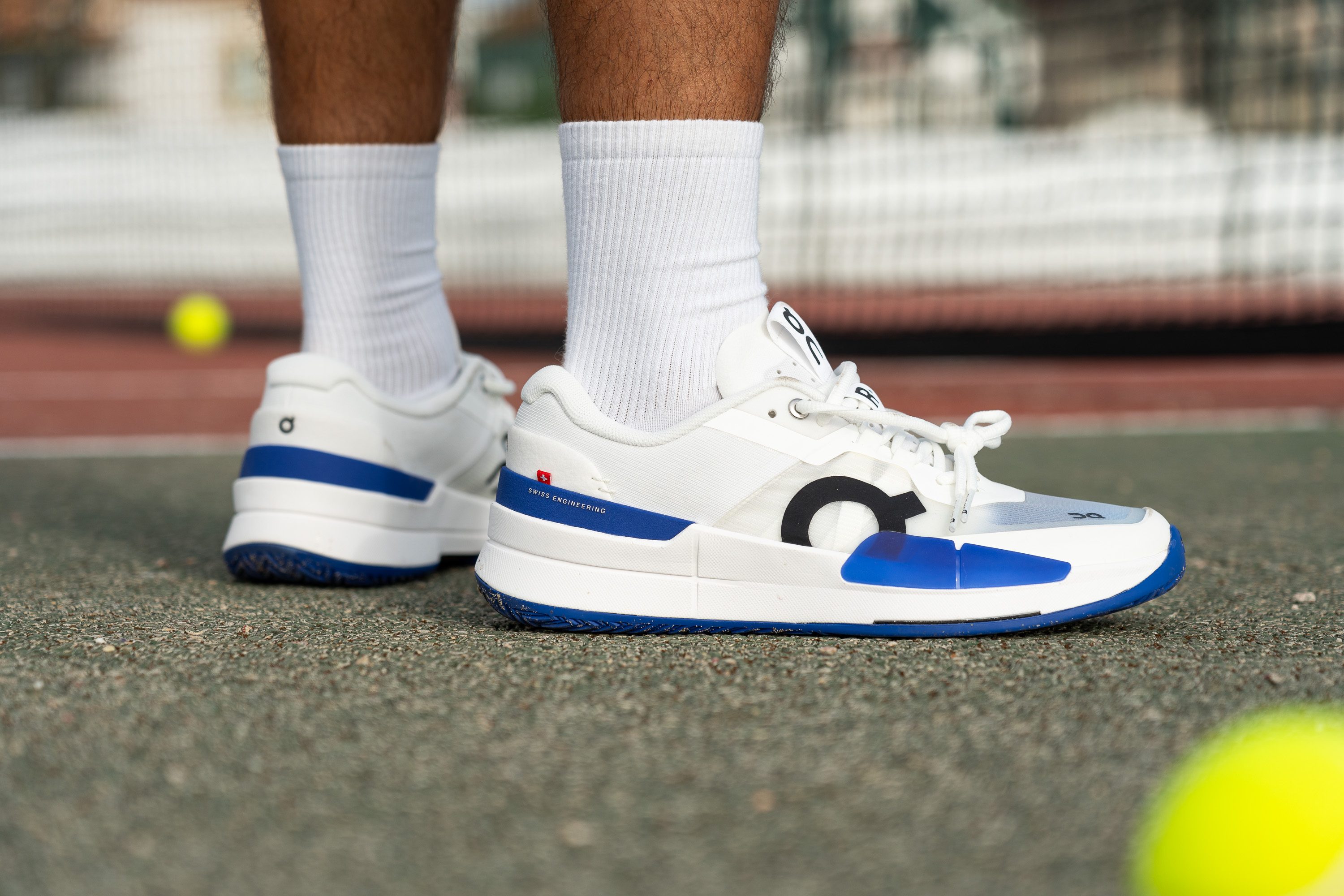
Who should NOT buy
Not everyone is going to feel their best in a firm and hard-to-bend tennis shoe. If you want a better cushioned option that feels more forgiving to the feet, we recommend the ASICS Court FF 3 and the Nike Vapor 11 instead.
Both of these shoes received excellent durability scores and yet are priced more reasonably.

Cushioning
Shock absorption
We found the On Roger Pro 2 to be a moderately cushioned tennis shoe with a pronounced court feel.
Even though we measured its forefoot shock absorption at a standard 64 SA, its heel is notably less protective at 84 SA. Not the best option for long matches, players with previous injuries, or folks who are used to having extra cushioning in their tennis shoes.
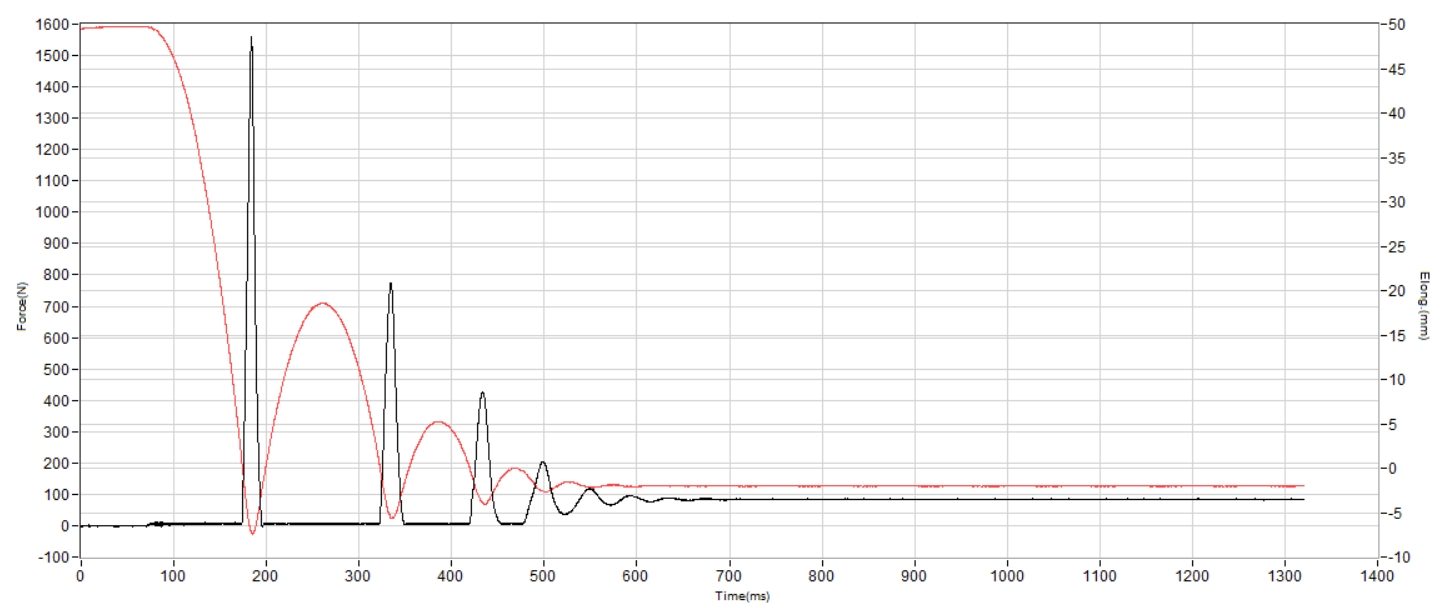
| The ROGER Pro 2 | 84 SA |
| Average | 99 SA |
Energy return
It also proved to be a low-rebound shoe with very low energy return measurements of 40.7% in the heel and 42.3% in the forefoot. Not much springback here, but a rather grounded experience.
| The ROGER Pro 2 | 40.7% |
| Average | 48.8% |
Heel stack
Based on our caliper measurements, its heel stack height comes in at 29.2 mm which is an average for the tennis shoe category.
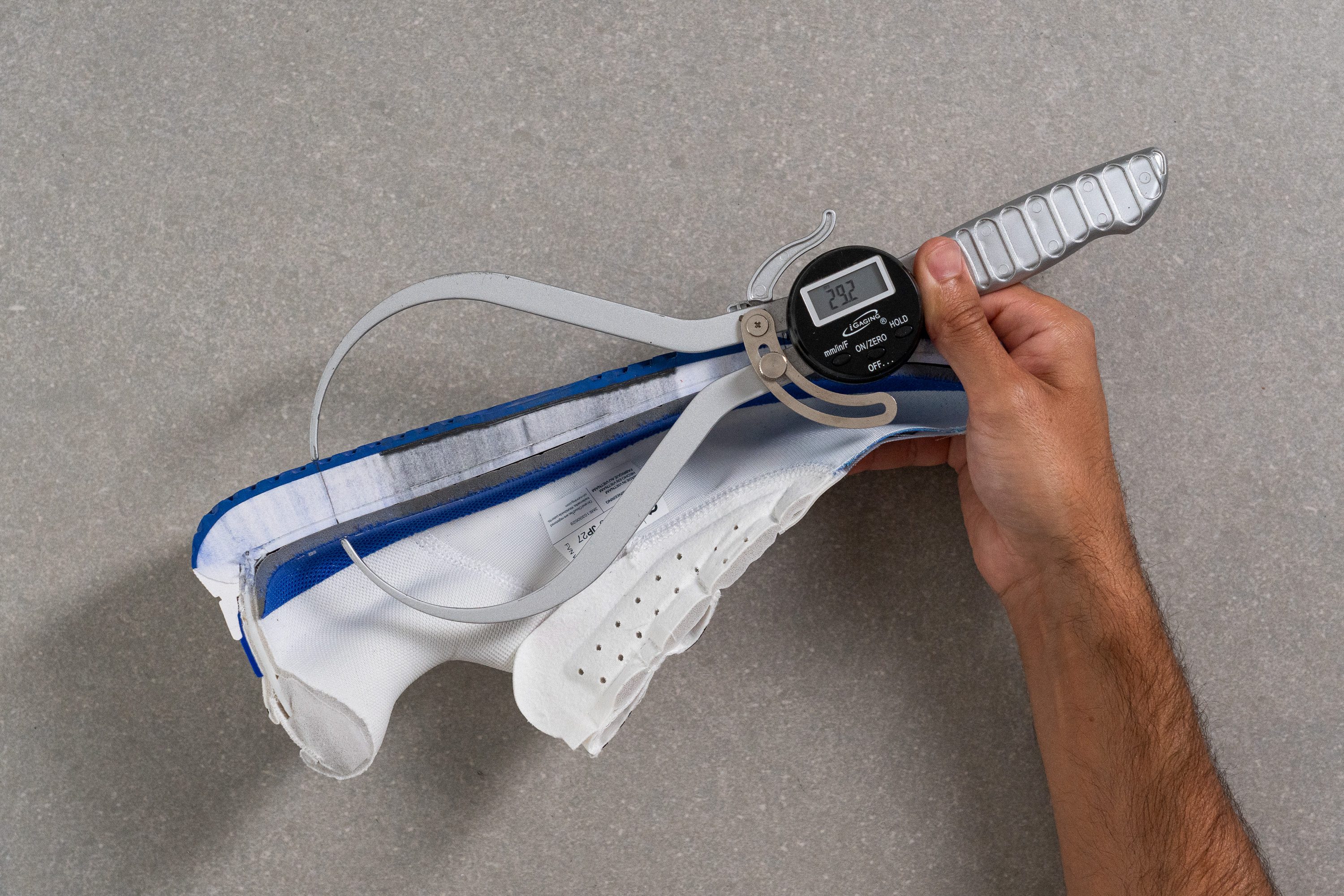
| The ROGER Pro 2 | 29.2 mm |
| Average | 29.2 mm |
Forefoot stack
The shoe's forefoot stack also showed nothing other than an average - 20.1 mm.
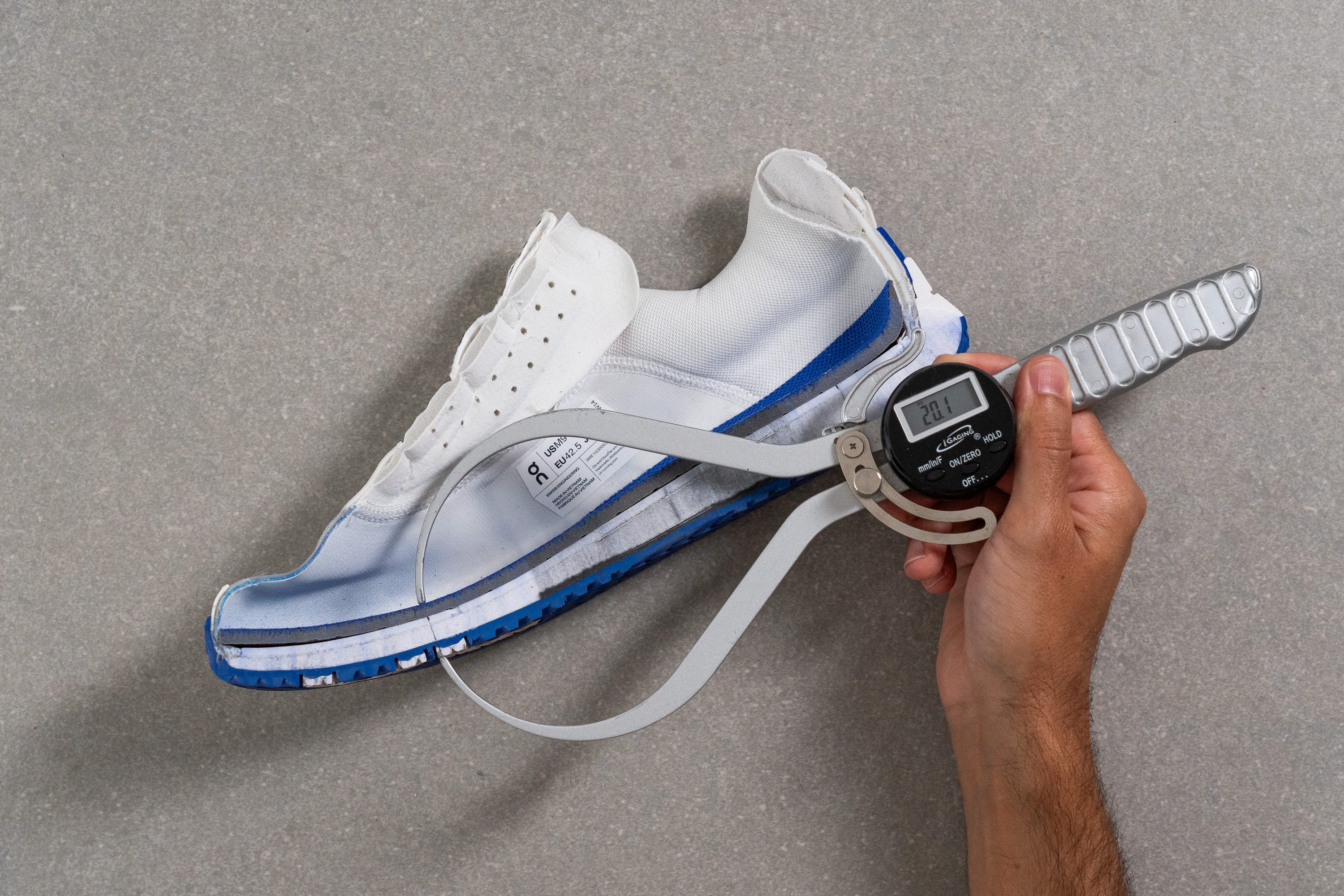
Considering that hard rubber comprises about 5.5 mm of that stack, the balls of our feet did not feel spoiled by cushioning at all.
| The ROGER Pro 2 | 20.1 mm |
| Average | 19.5 mm |
Drop
According to the brand's official specs, the Roger Pro 2 has a heel-to-toe drop of 8 mm. Our own measurements came very close to that number showing 9.1 mm. But this minor difference can hardly be felt on foot.

Tennis shoes tend to have a moderate heel elevation of 8-10 mm which puts the foot in an optimal position for the sport. The heel packs more foam for impact protection and takes the pressure off the Achilles while the forefoot sits closer to the ground allowing better control over the footwork.
| The ROGER Pro 2 | 9.1 mm |
| Average | 9.7 mm |
Midsole softness
Designed to generate speed, this On shoe offers a very firm underfoot experience.
This can either be a blessing or a deal breaker, depending on what kind of platform you are looking for. Some people prefer this unforgiving setup as it helps them get up and go in a split-second while others will be turned off by the lack of comfort and shock absorption.
The shoe's midsole is on the firmer side of our tennis shoe catalog. With a durometer reading of 32.3 HA, we found it to be 10% firmer than average.
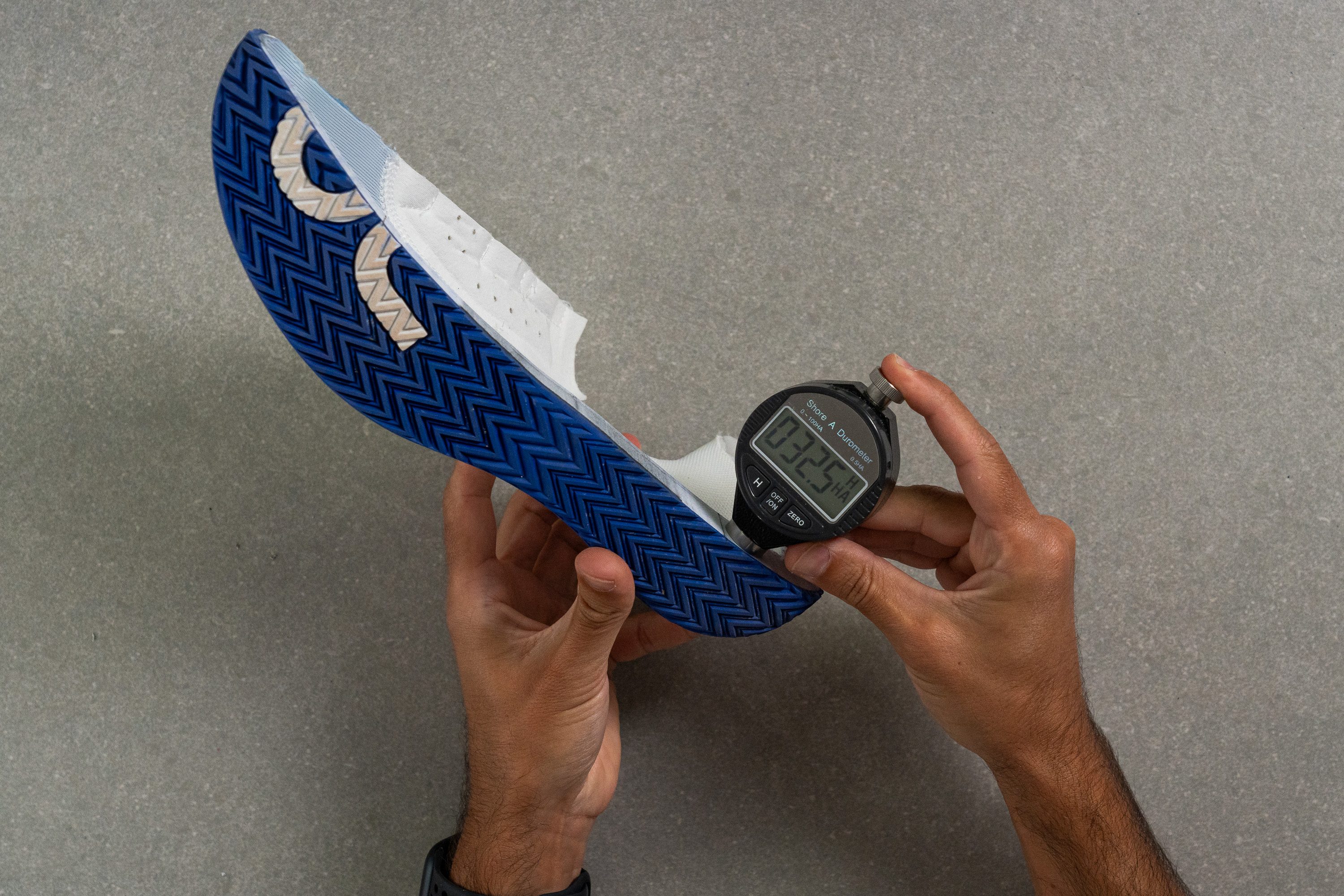
| The ROGER Pro 2 | 32.3 HA |
| Average | 28.1 HA |
Size and fit
Size
On The ROGER Pro 2 fits slightly small (31 votes).
Width / Fit
The shoe provides a reasonably accommodating fit, which was confirmed by the gel mold of its interiors.
In the widest part, at 94.7 mm, it is slightly wider than the average tennis shoe. We believe this little buffer is necessary, considering the risk of that lateral TPU clip pressing against the pinkie toe.

| The ROGER Pro 2 | 94.7 mm |
| Average | 92.9 mm |
Toebox width
The Roger Pro 2 tapers very moderately towards the toes, showing a standard width of 70.7 mm near the big toe.
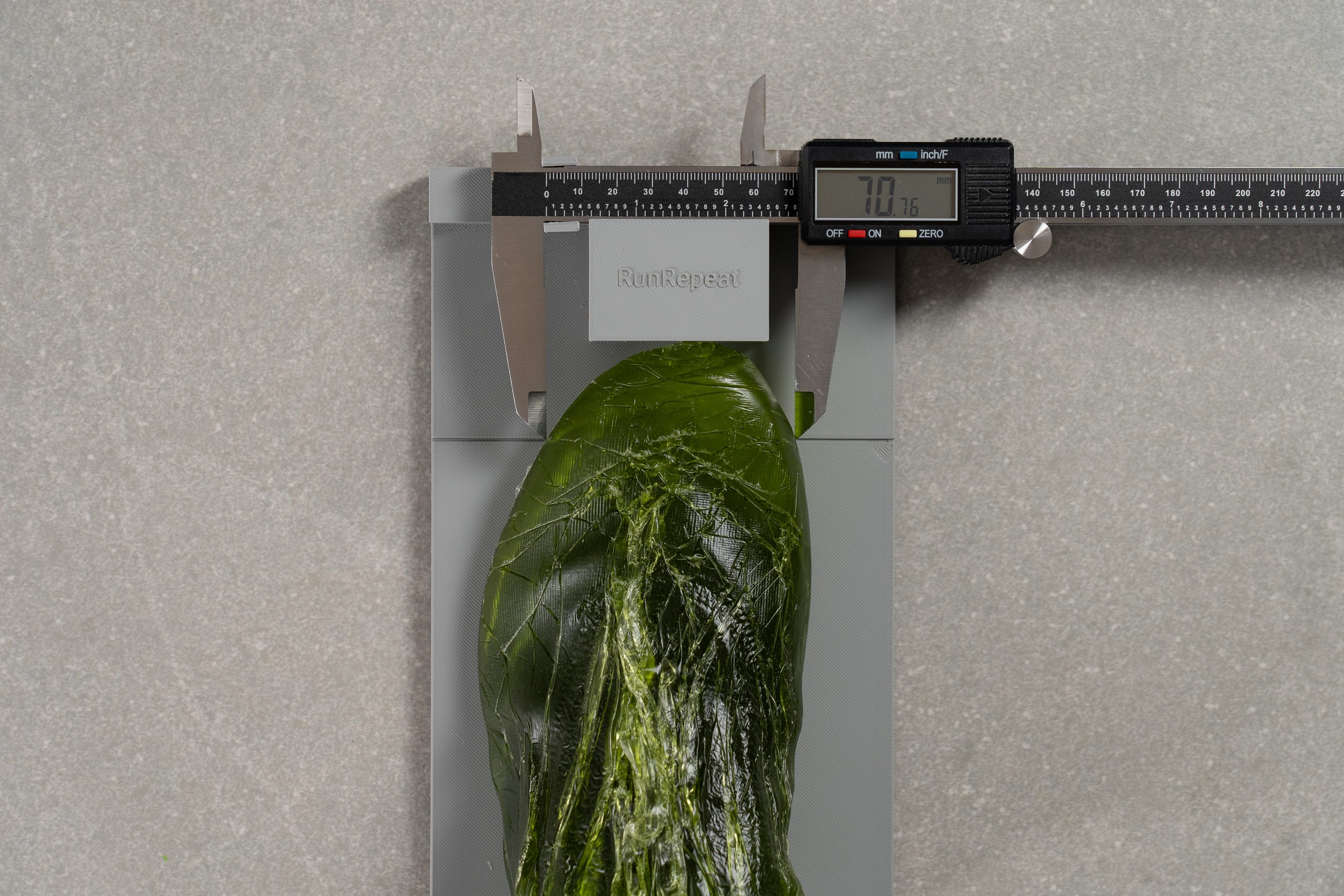
| The ROGER Pro 2 | 70.7 mm |
| Average | 69.2 mm |
Toebox height
It should be noted, however, that the toebox height is limited in this On tennis shoe. Our caliper showed one of the lowest readings in this area at 20.7 mm. This could potentially aggravate toe-related conditions like black toenails.
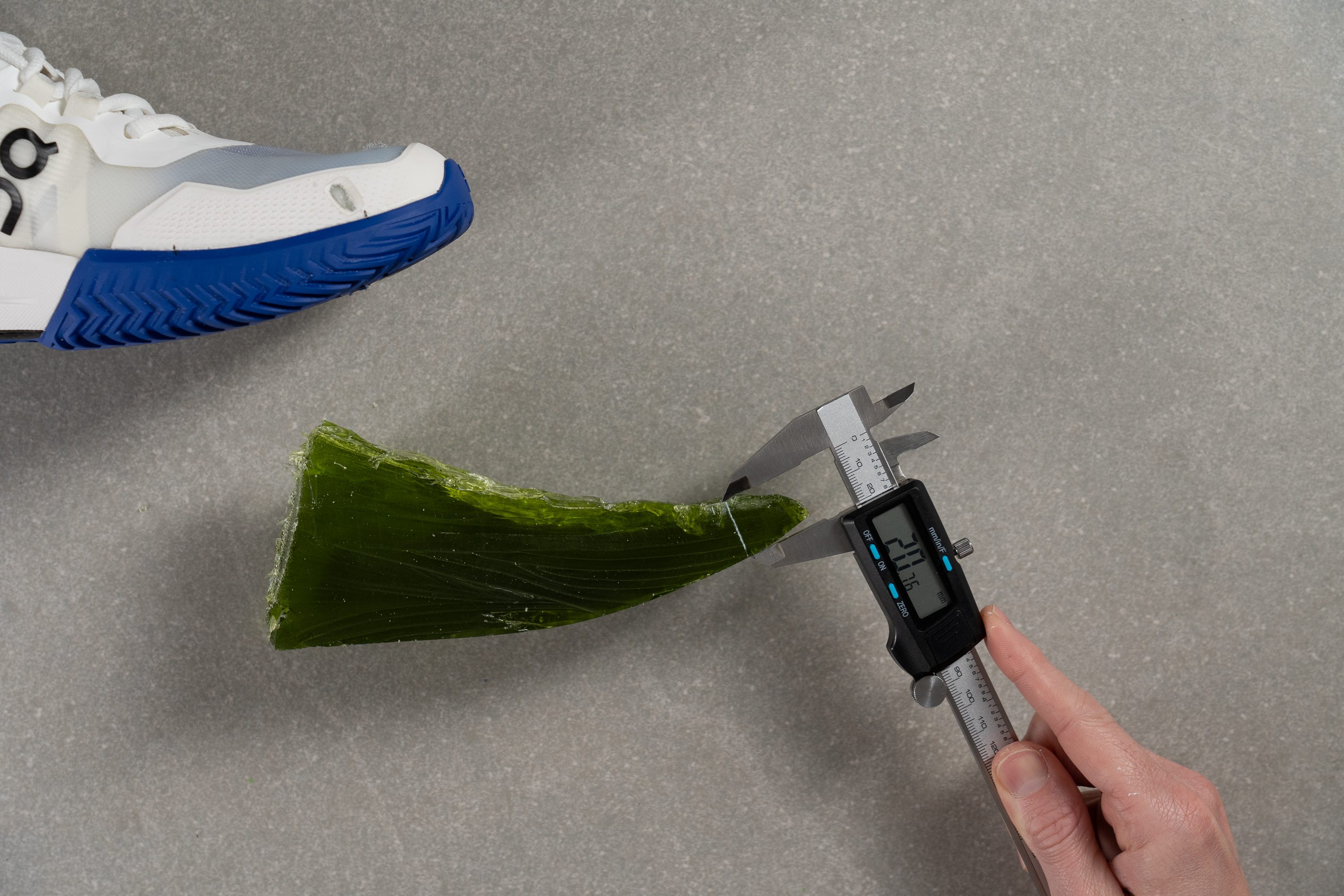
| The ROGER Pro 2 | 20.7 mm |
| Average | 25.1 mm |
Laces
Additional eyelets allow you to customize the lacing for a more secure lockdown.
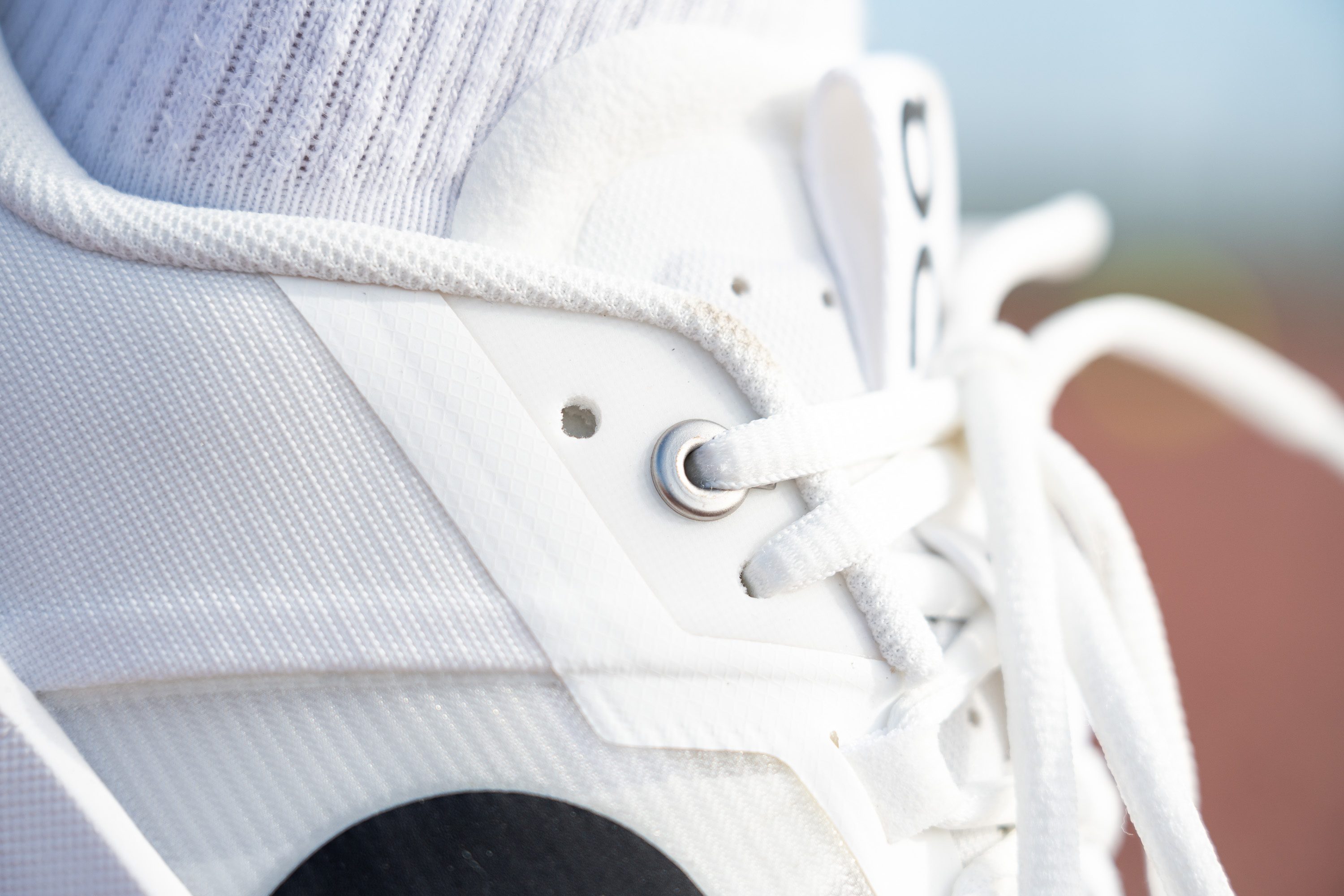
And there is a little play on words in the shoe's aglets - "Put me ON."

Traction / Grip
Forefoot traction
Showing a high friction score of 0.81, the On The Roger Pro 2 proved its consistent grip in our lab test. This hard court shoe will help you stop on a dime and push off with maximum force while retaining speed on corners.
| The ROGER Pro 2 | 0.81 |
| Average | 0.76 |
Outsole design
On chose a no-frills herringbone traction pattern for the Roger Pro 2. It also cut down on the rubber where it's not necessary (inner part of the midfoot), exposing a carbon Speedboard plate.
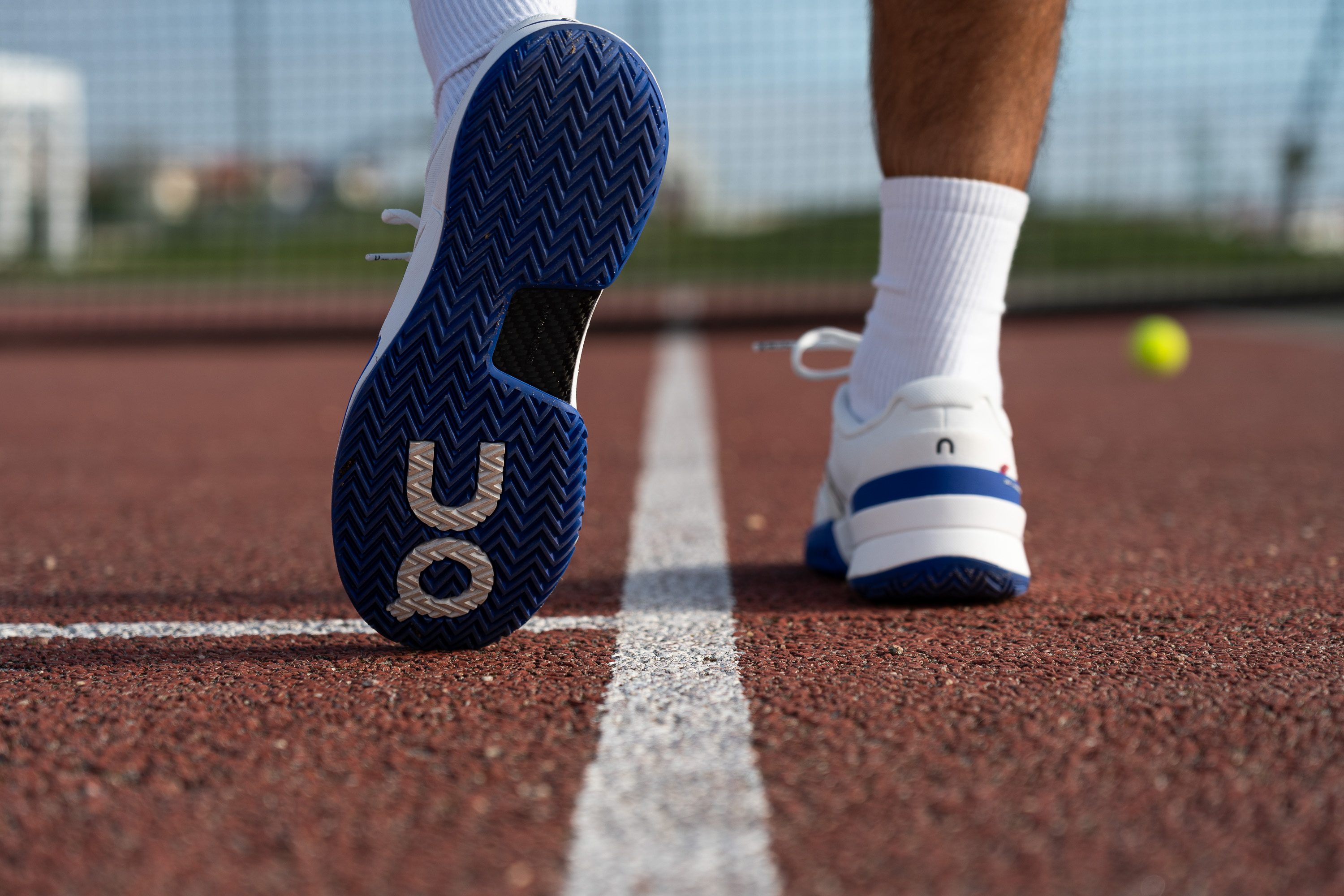
Flexibility / Stiffness
The On Roger Pro 2 proved to be one of the stiffest tennis shoes we've tested in our lab.
It took twice as much force to bend the Roger Pro 2 to a 30-degree angle as it takes an average tennis shoe. According to our shoe flexing tester, it required as much as 24.3N and it definitely reflected in this On shoe's very stable ride.
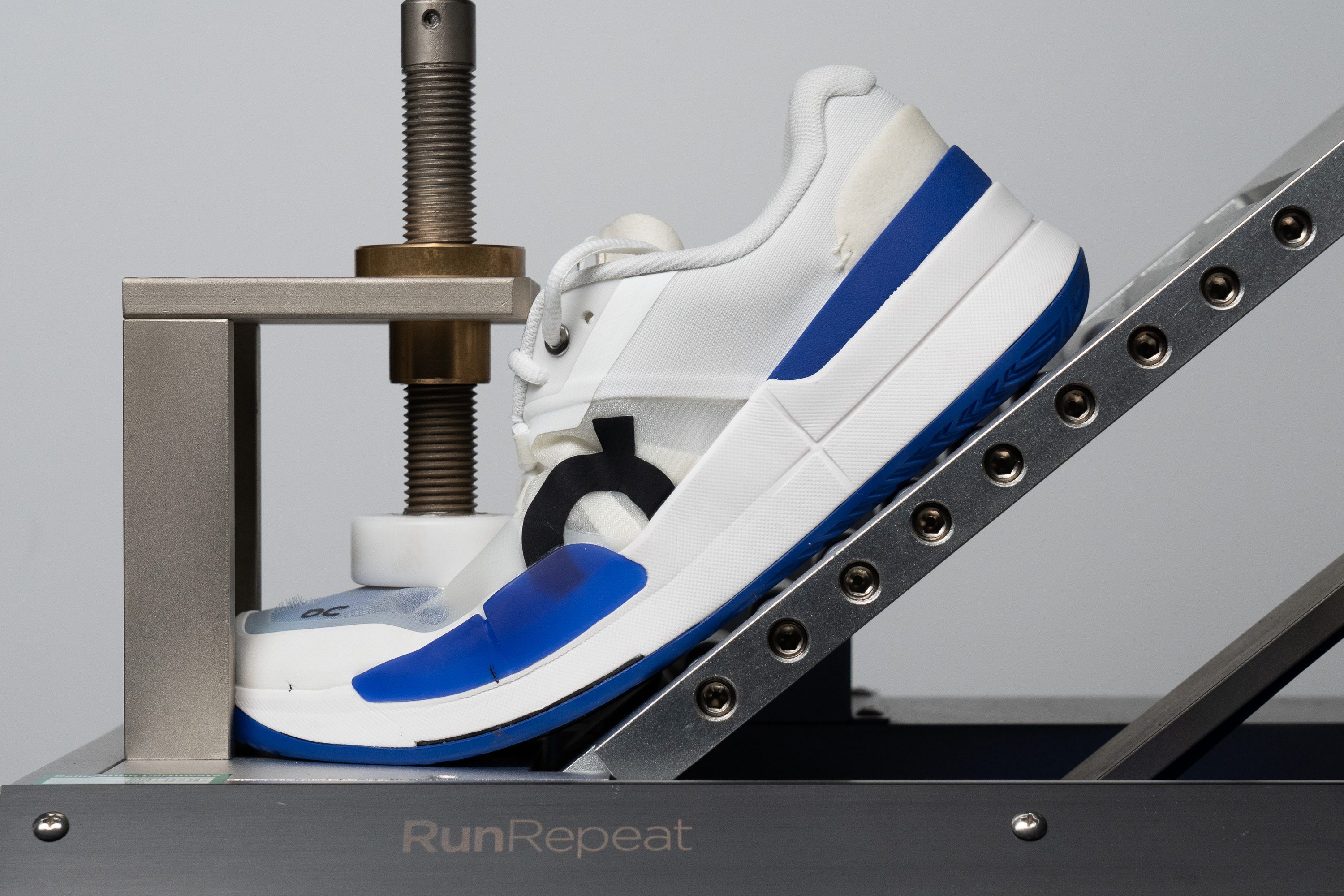
This rigidity is primarily due to the Speedboard plate embedded into the bottom of its midsole. This carbon fiber layer generated a lot of rigidity in the shoe's midfoot, stabilizing the foot from every angle.
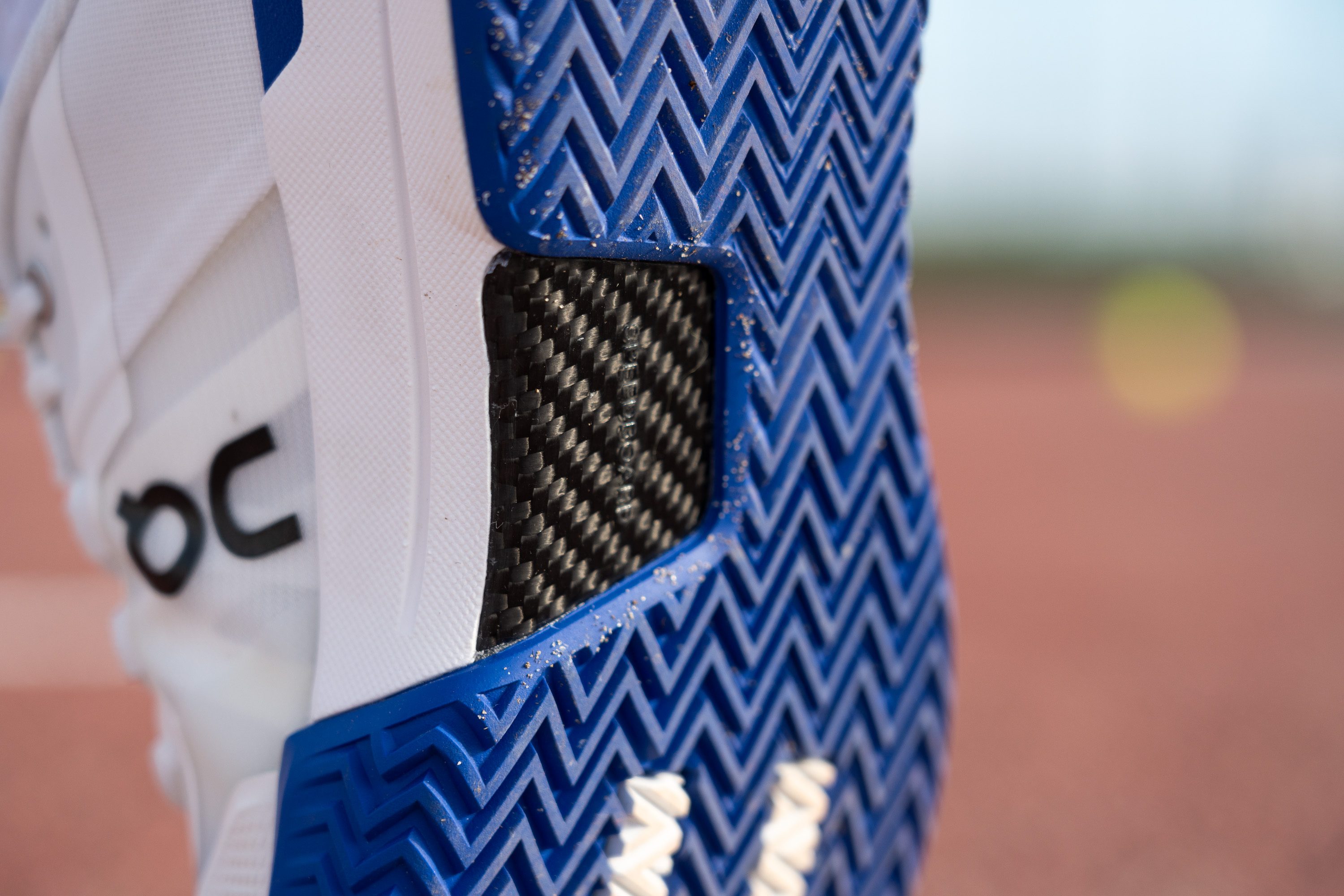
| The ROGER Pro 2 | 24.3N |
| Average | 16.6N |
Weight
During the playtest, the On Roger Pro 2 felt lightning fast on our feet! So when we put it on the scale, we were genuinely surprised by its static weight.
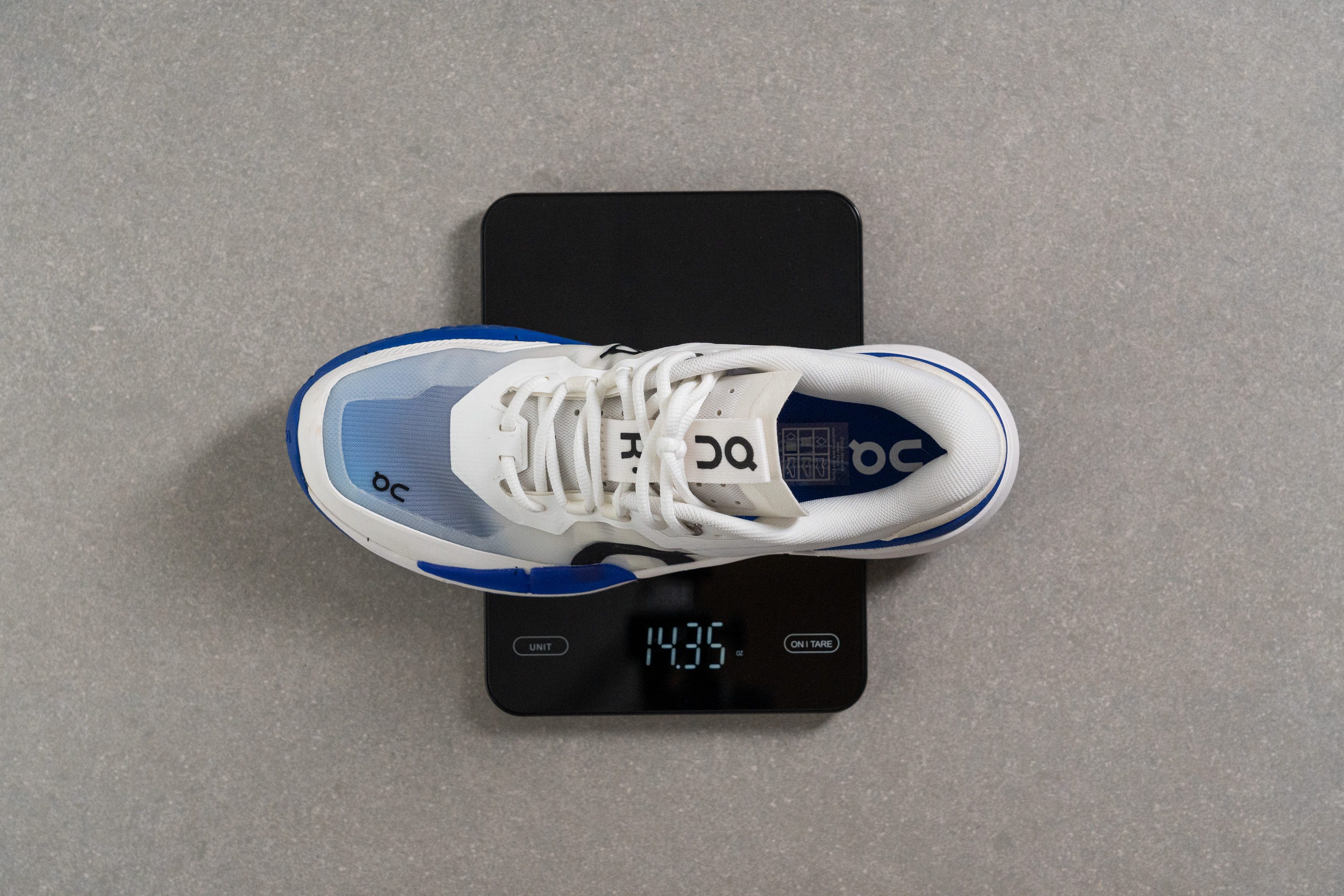
At 14.4 oz (407g) in a men's US size 9, it is about 1.5 ounces heavier than average! And yet it feels quick thanks to its stable, responsive, and grippy construction.
| The ROGER Pro 2 | 14.4 oz (407g) |
| Average | 12.8 oz (362g) |
Breathability
An incredibly thin, even translucent, mesh upper of the Roger Pro 2 immediately caught our eyes. But is it just as airy as it looks? We brought a smoke-pumping machine to find out.
We were impressed to see how quickly the smoke escaped through the shoe's toebox, leaving no doubts about its ventilation capacity. The upper is so thin and transparent, we could almost see right through it! Plus, the shoe has perforations all over the tongue for enhanced ventilation.
Curious about the engineering behind this magic mesh, we took a closer look at it through our microscope.
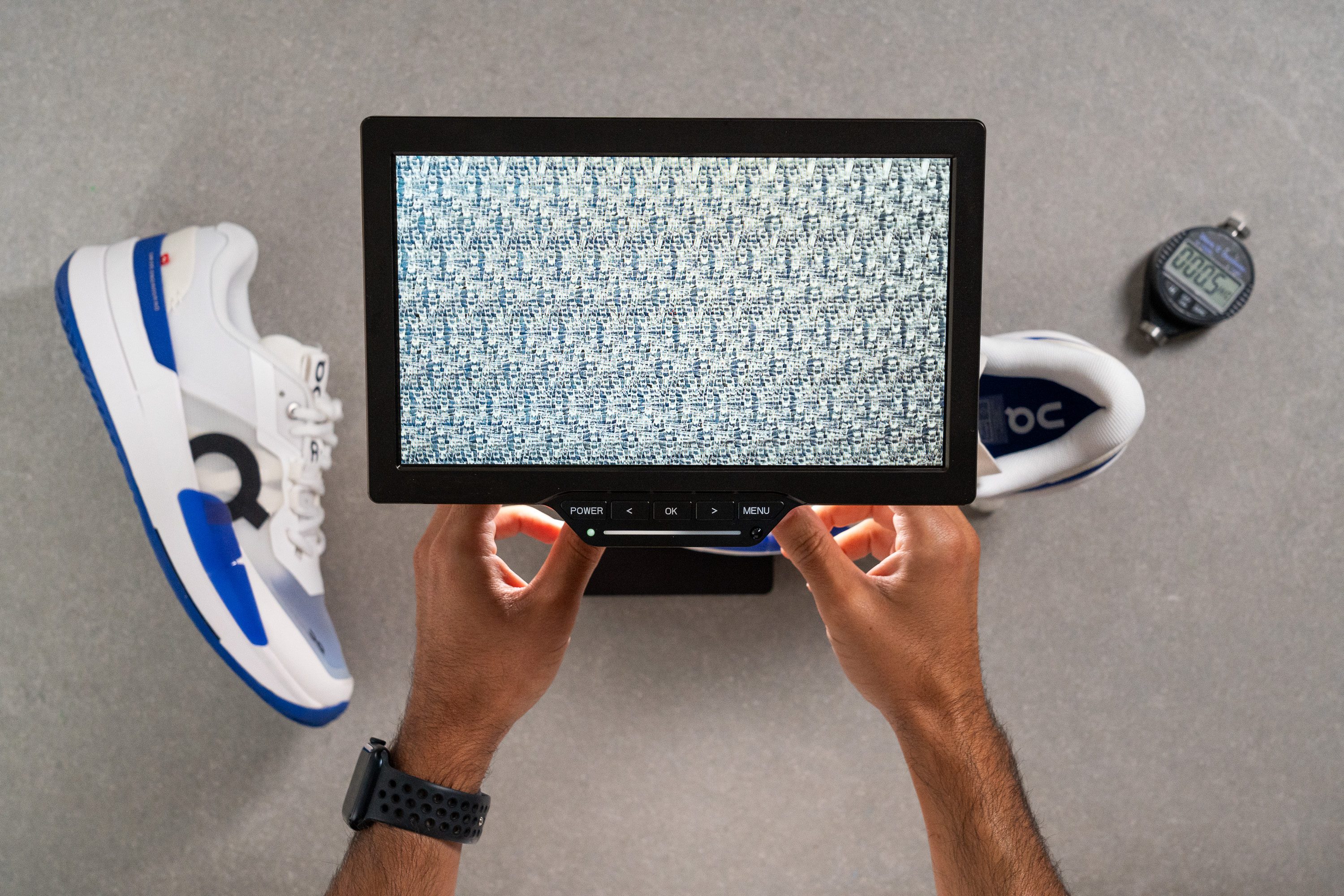
Just look at those mesmerizing patterns! This is the most intricate chainlinking we've seen on a shoe but it works wonders with airflow.
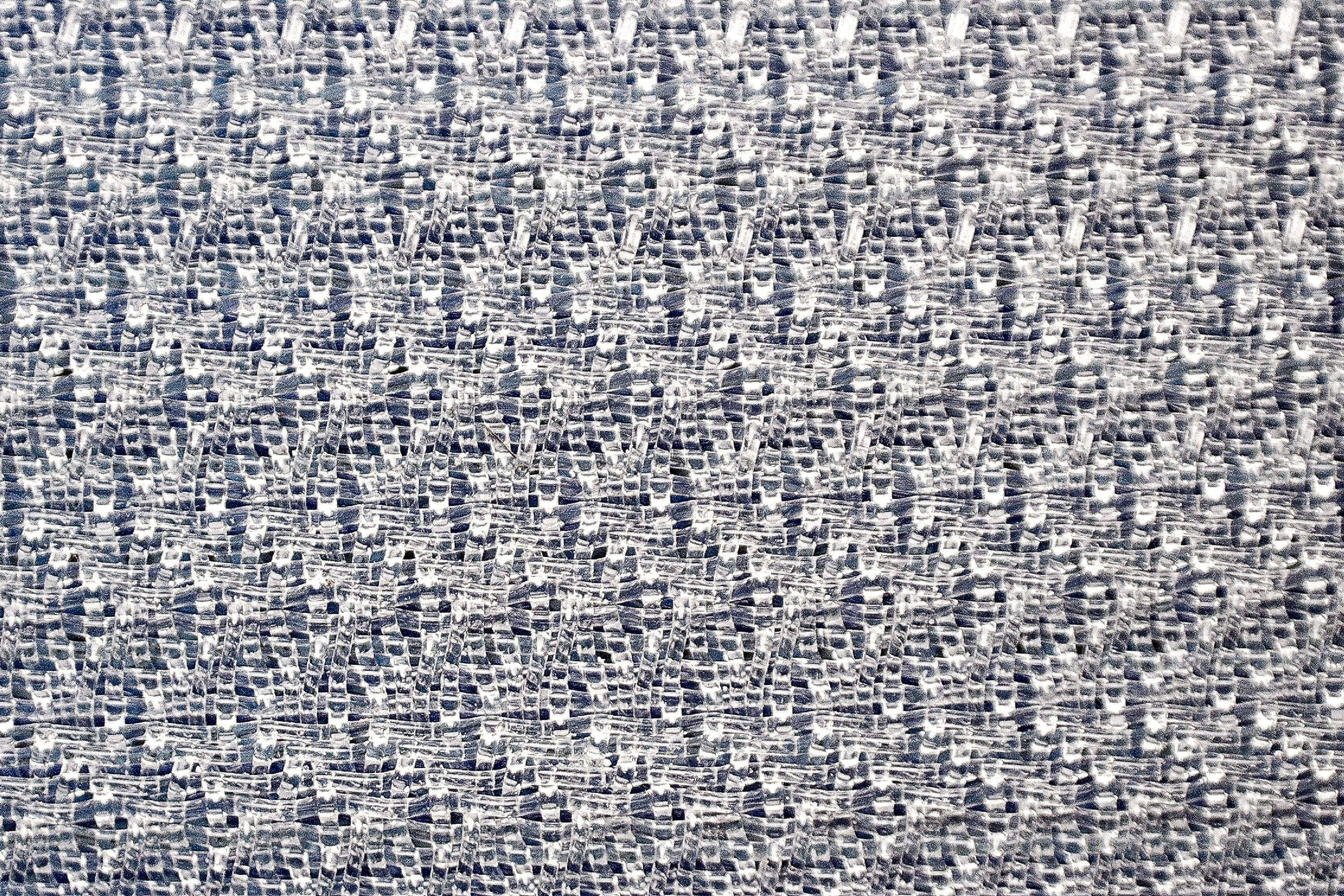
We trust the Roger Pro 2 to keep your feet refreshed on a hot sunny day and thus give it the maximum breathability score of 5 out of 5!
| The ROGER Pro 2 | 5 |
| Average | 3.2 |
Stability
Lateral stability test
The On Roger Pro 2 kept us exceptionally surefooted as we dashed from side to side, took off, and bounced back from each shot. Because we didn't lose any time or energy on stabilizing our feet, the experience felt dynamic and speedy.
We attribute this agile experience to the shoe's firm and grounded platform as well as internal and external stabilizing components.
Torsional rigidity
As a whole, the Roger Pro 2 feels remarkably stiff. Our manual test showed that it is nearly impossible to twist!
Even when we applied maximum force, the shoe didn't yield at all! This amount of torsional rigidity certainly deserves the highest score of 5.
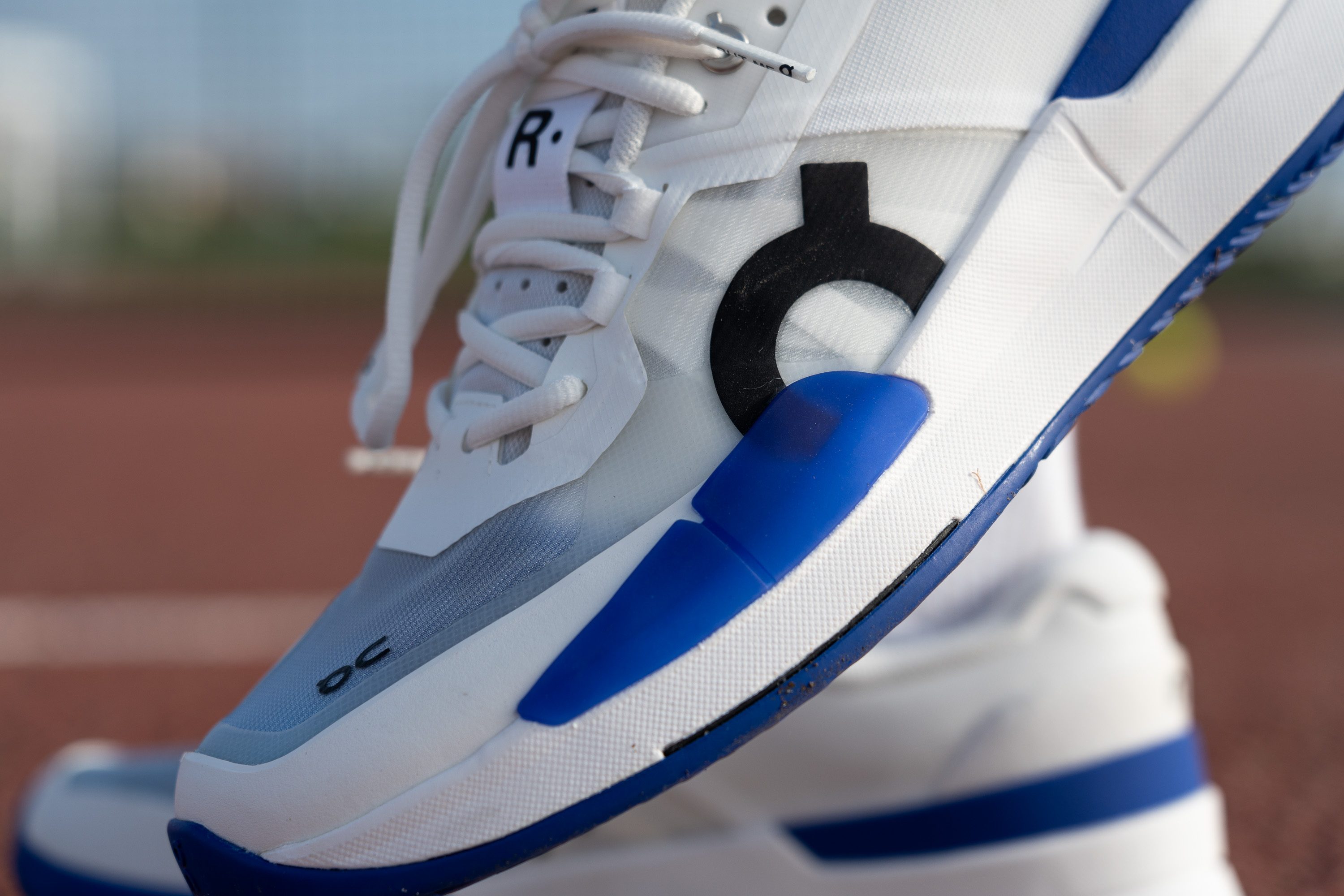
We believe that the stiffness comes from the shoe's sturdy TPU clips on the sides as well as the carbon fiber Speedboard plate inside the midsole.
| The ROGER Pro 2 | 5 |
| Average | 4.4 |
Heel counter stiffness
A sturdy multi-layered heel counter is another major stability element of the shoe.
Assessing its rigidity on a 1-5 scale, we confidently gave it a high score of 4. It completely refused to give in as we tried to push and squeeze it in our manual test.

On the court, this translated to a pretty firm heel clutch that didn't allow our heels and ankles to shift around. In addition, our heels seemed to have sunk into the shoe's generous heel padding which prevented heel slips.
| The ROGER Pro 2 | 4 |
| Average | 4.1 |
Midsole width - forefoot
Last but not least, the On Roger Pro 2 has a pretty large landing and push-off area.

We found it to be even larger than average measuring the widest part of the forefoot at 115.1 mm.
| The ROGER Pro 2 | 115.1 mm |
| Average | 111.9 mm |
Midsole width - heel
Checking the heel, our caliper showed a standard measurement of 89.2 mm in the widest part. This is a solid midsole width to create a stable and reliable base.
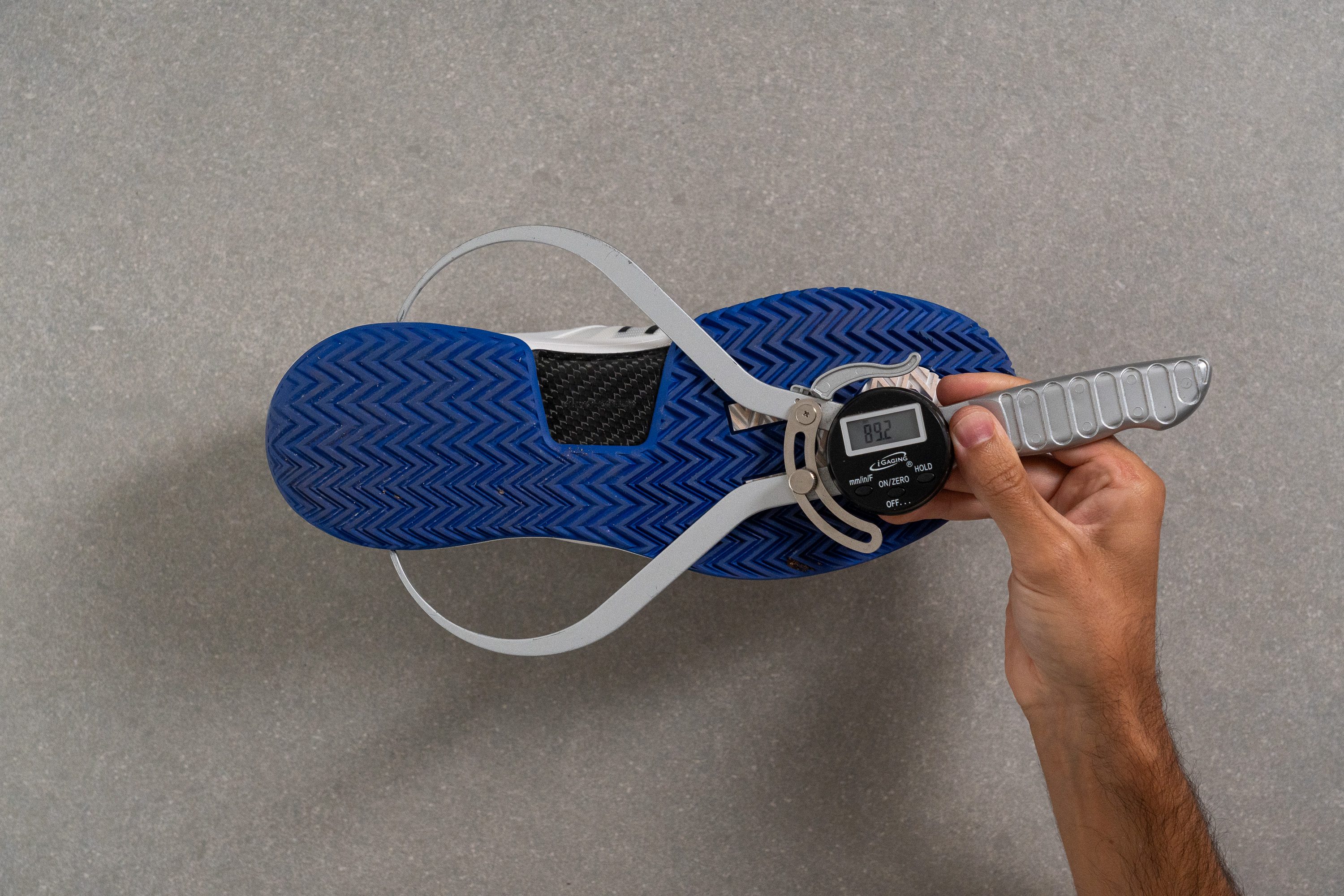
| The ROGER Pro 2 | 89.2 mm |
| Average | 89.6 mm |
Durability
Toe guard durability
Considering the shoe's high price point, we expected an extraordinary level of toe protection and wear resistance from the Roger Pro 2. But once we grabbed our Dremel, we were only 22 seconds away from disappointment...
By the end of the test, our Dremel burnt straight through the rubber overlay! This is unacceptable considering that much cheaper shoes only got a dent in the same conditions.
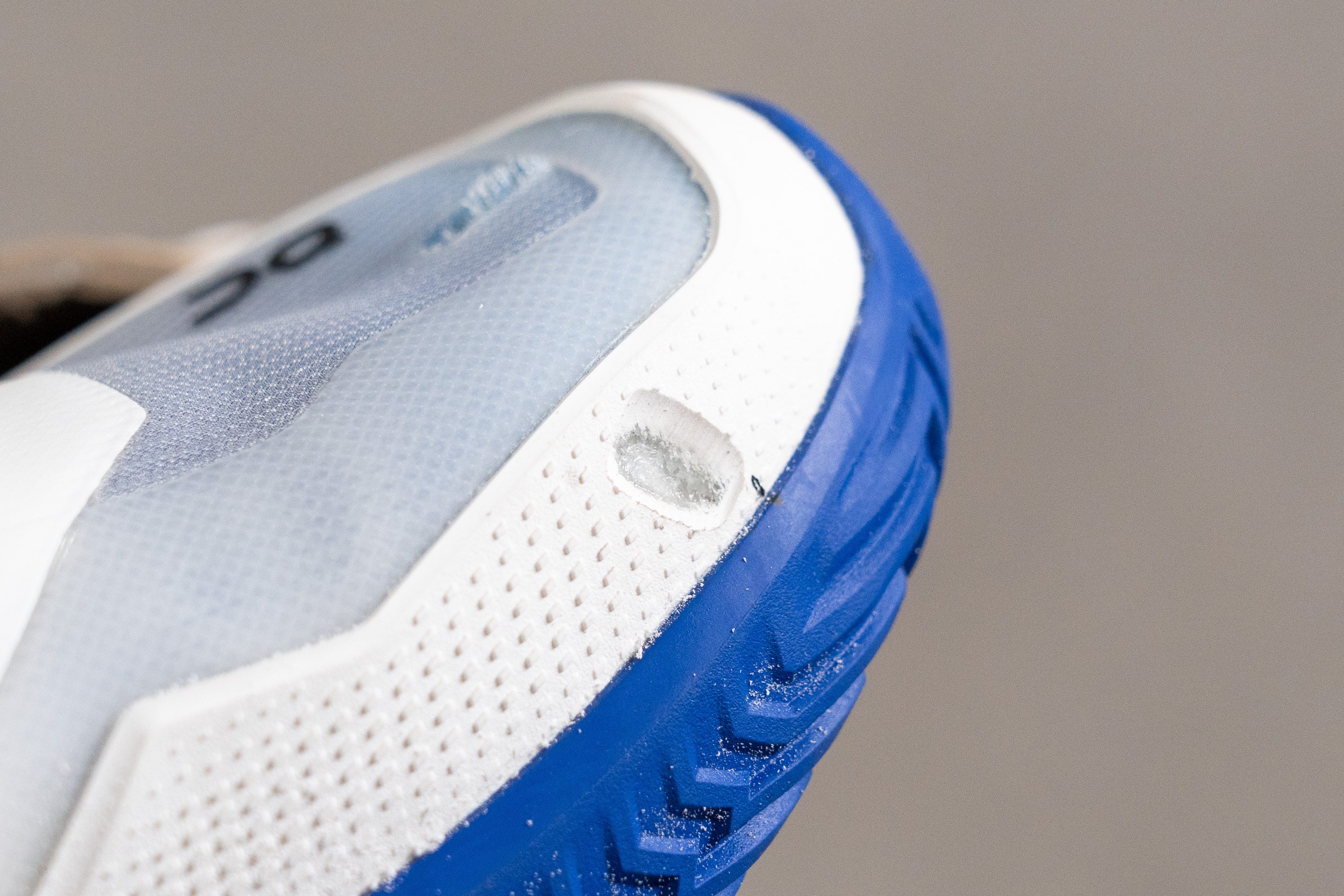
Unfortunately, the shoe's poor toe drag protection deserves nothing more than 1 out of 5 on the durability scale.
| The ROGER Pro 2 | 1 |
| Average | 3.3 |
Toebox durability
It's odd to read "abrasion-resistant" in the description of the shoe's mesh considering how paper-thin it is. We fear a single brush against the court will tear this fabric for good.
And just as we anticipated, the mesh failed our 12-second Dremel test in which we exposed it to sandpaper at a 5K RPM speed. The glaring hole convinced us to rate the shoe's toebox mesh durability with the lowest score of 1.
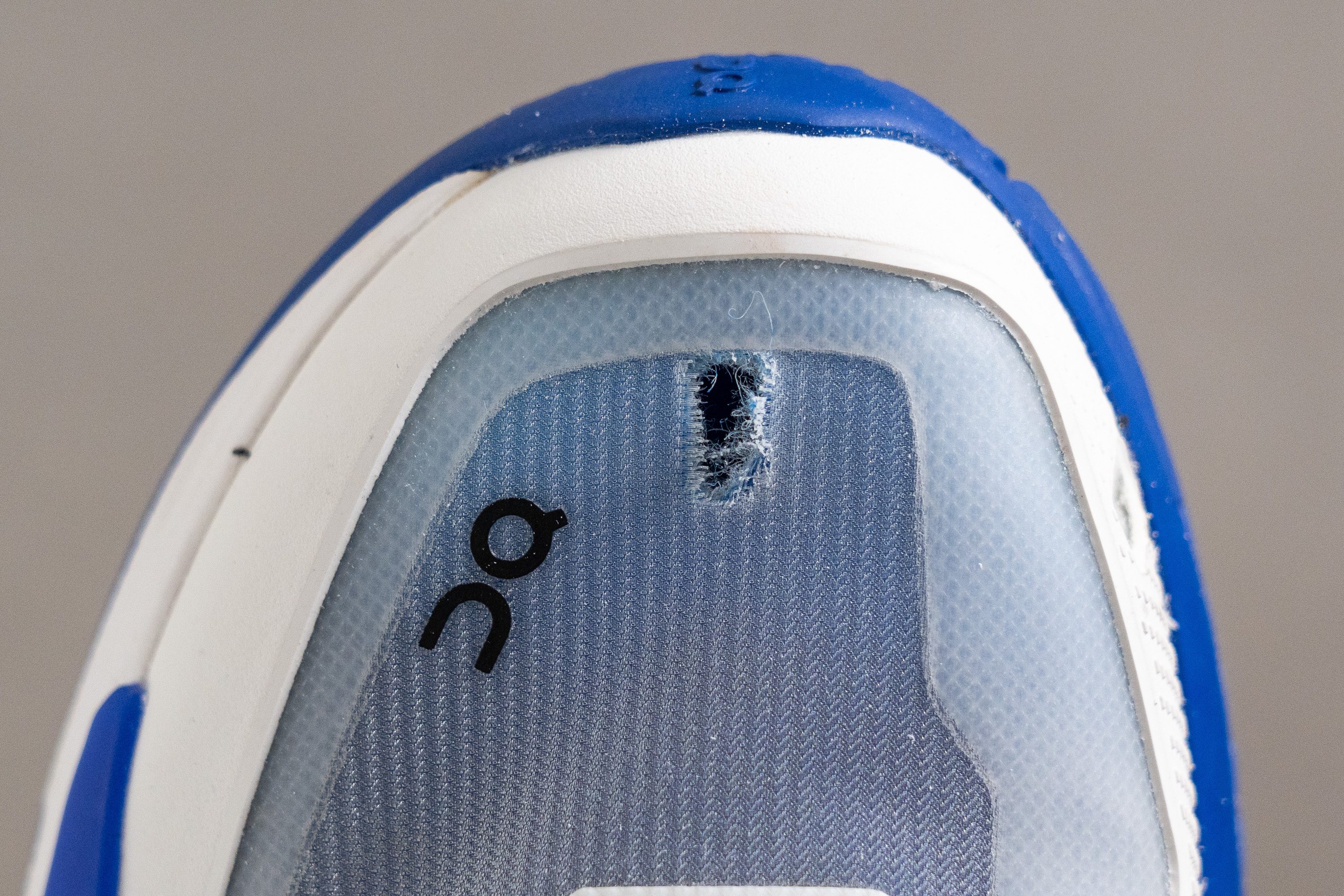
| The ROGER Pro 2 | 1 |
| Average | 3.7 |
Heel padding durability
The inner fabric of the Roger Pro 2 seemed a little more promising.
But even though the damage was rather moderate, we couldn't rate the shoe's heel padding durability any higher than 3 out of 5.
With the amount of friction that occurs inside the shoe in professional tennis, we are concerned with the material choices for this expensive shoe.
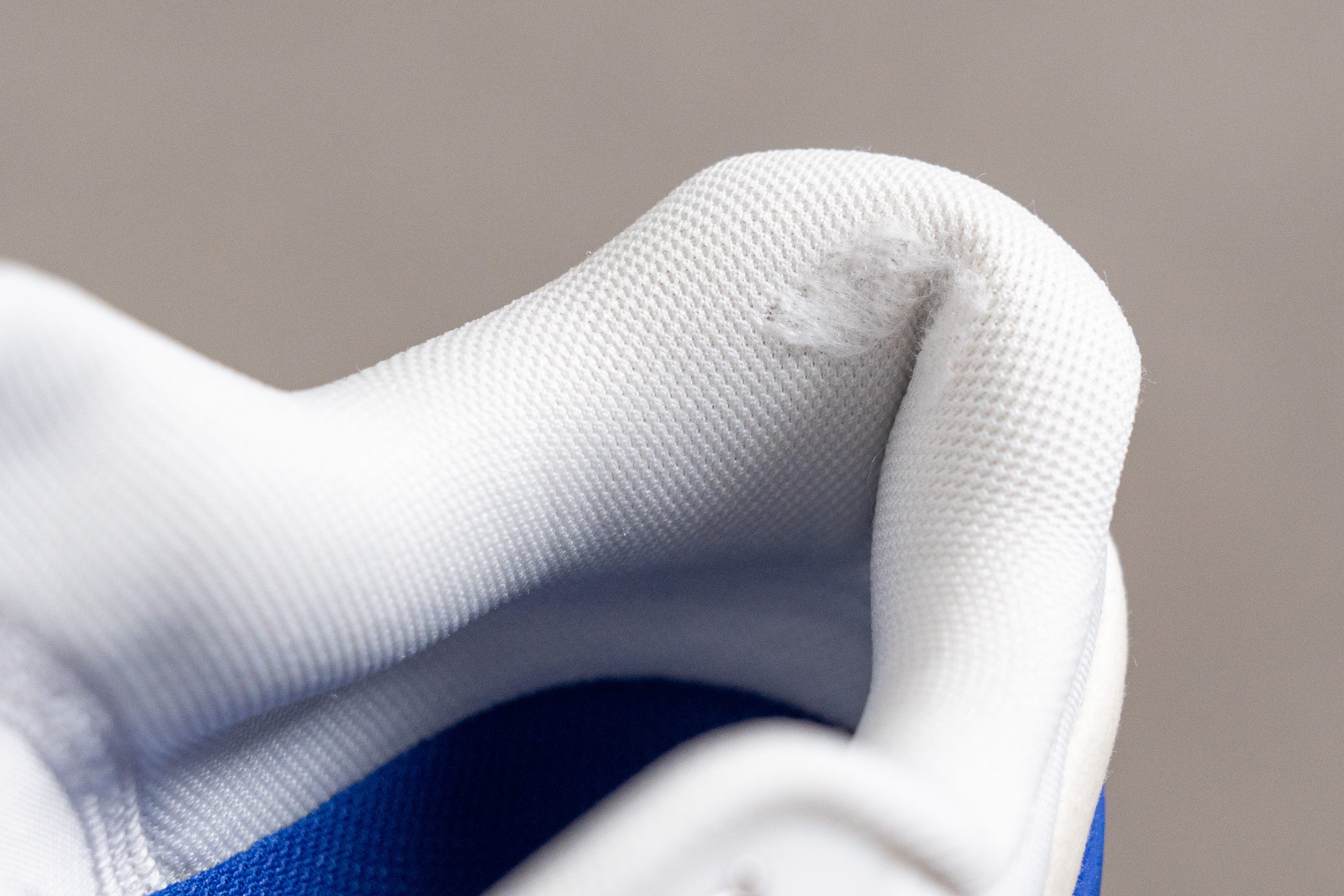
| The ROGER Pro 2 | 3 |
| Average | 3.3 |
Outsole hardness
On the bright side, the rubber outsole of this On tennis shoe seems to be more hard-wearing than the upper.
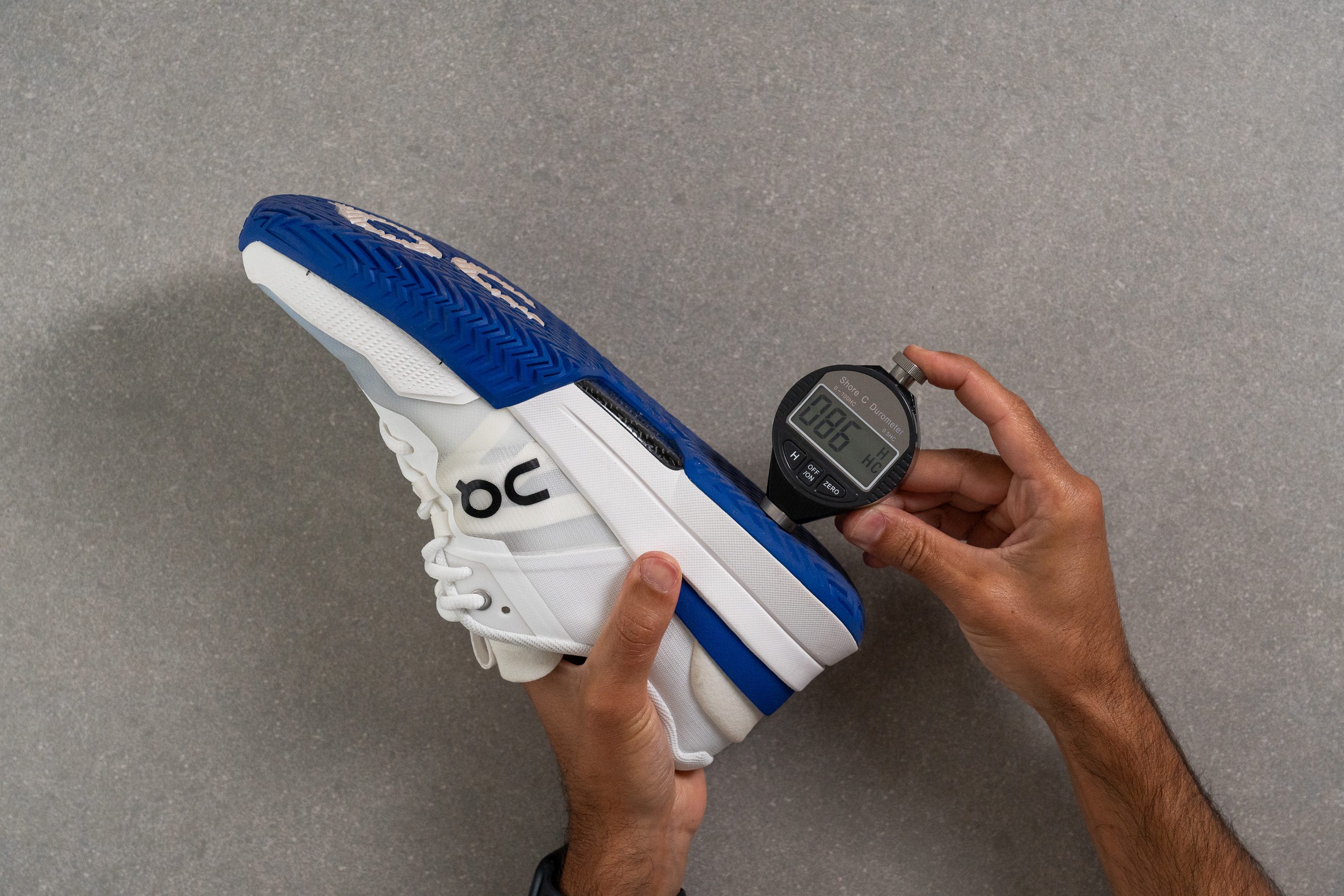
Checking its hardness with a durometer returned 85.5 HC which is a solid reading for a tennis shoe.
| The ROGER Pro 2 | 85.5 HC |
| Average | 86.0 HC |
Outsole durability
A hard rubber compound is a good start but how does it hold up against aggressive wear and tear?
Setting the Dremel speed high (10K RPM), we tested the limits of the shoe's outsole for 22 seconds. Luckily, the dent turned out to be as minor as 0.8 mm which is an average result among high-performance tennis shoes.

| The ROGER Pro 2 | 0.8 mm |
| Average | 0.8 mm |
Outsole thickness
Checking the shoe's outsole thickness further raised our confidence in it. In the heel (where the traction pattern is smoother), our caliper showed a standard reading of 4.3 mm.

But in the forefoot (where lugs are protruding), we measured a whole millimeter more! At 5.6 mm, this is one of the stoutest tennis shoe outsoles we've come across.
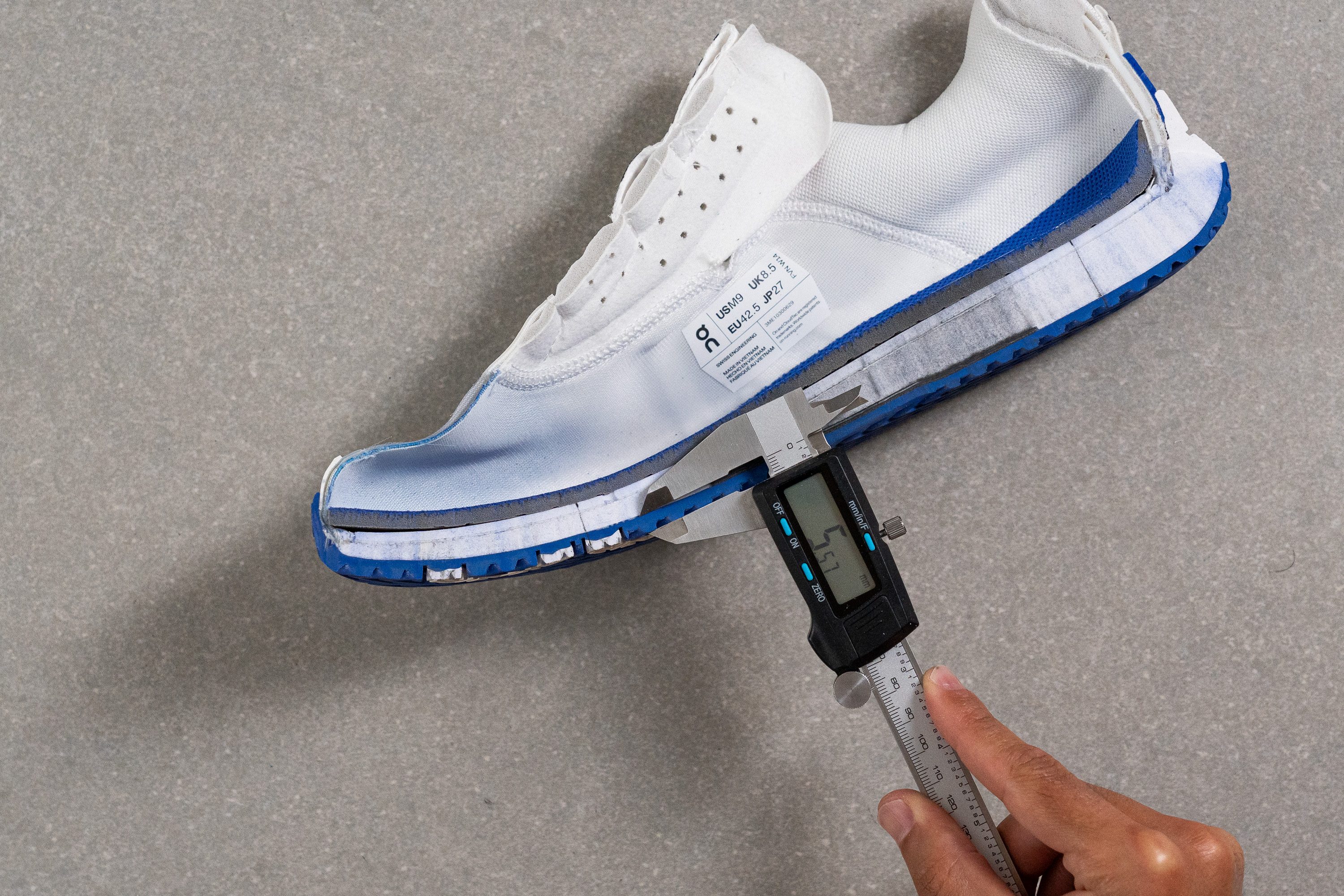
| The ROGER Pro 2 | 4.3 mm |
| Average | 4.2 mm |
Misc
Insole thickness
A touch of cushioning is offered by the shoe's moderately padded insole. We measured its thickness at 4.5 mm in the heel area.

| The ROGER Pro 2 | 4.5 mm |
| Average | 5.1 mm |
Removable insole
The insole of the Roger Pro 2 is easy to remove in case a custom orthotic is needed.
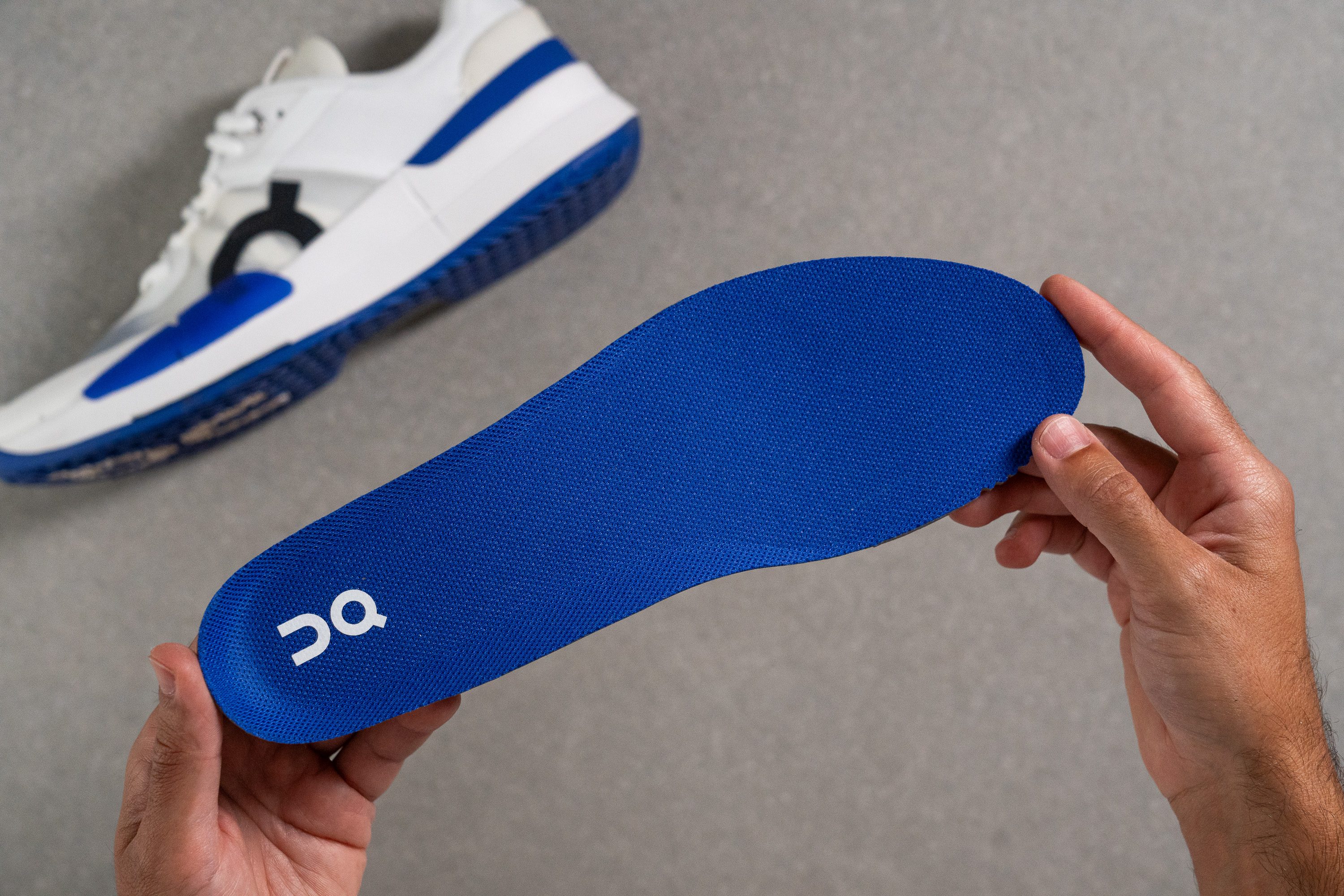
But we didn't feel the need to swap it because it felt optimal for the shoe's overall stable and speedy build. Plus, the back side of it is covered in small indentations that help keep the insole in place during intense movements.
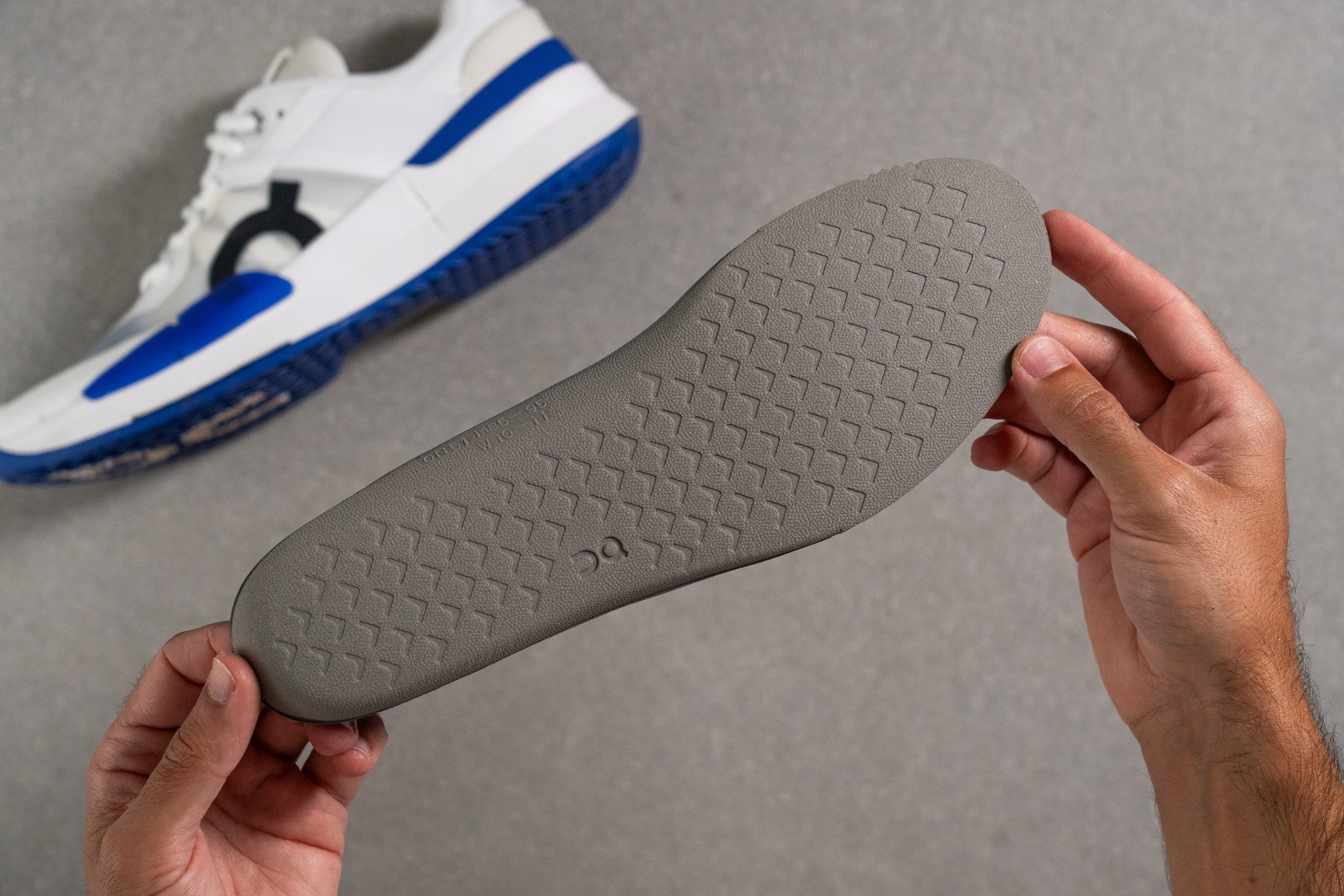
| The ROGER Pro 2 | Yes |
Tongue padding
The On Roger Pro 2 didn't feel particularly cushy or padded from the inside but it packed enough foam to protect our insteps from the lace pressure.
Our caliper measured a standard tongue thickness of 6.7 mm in the shoe.
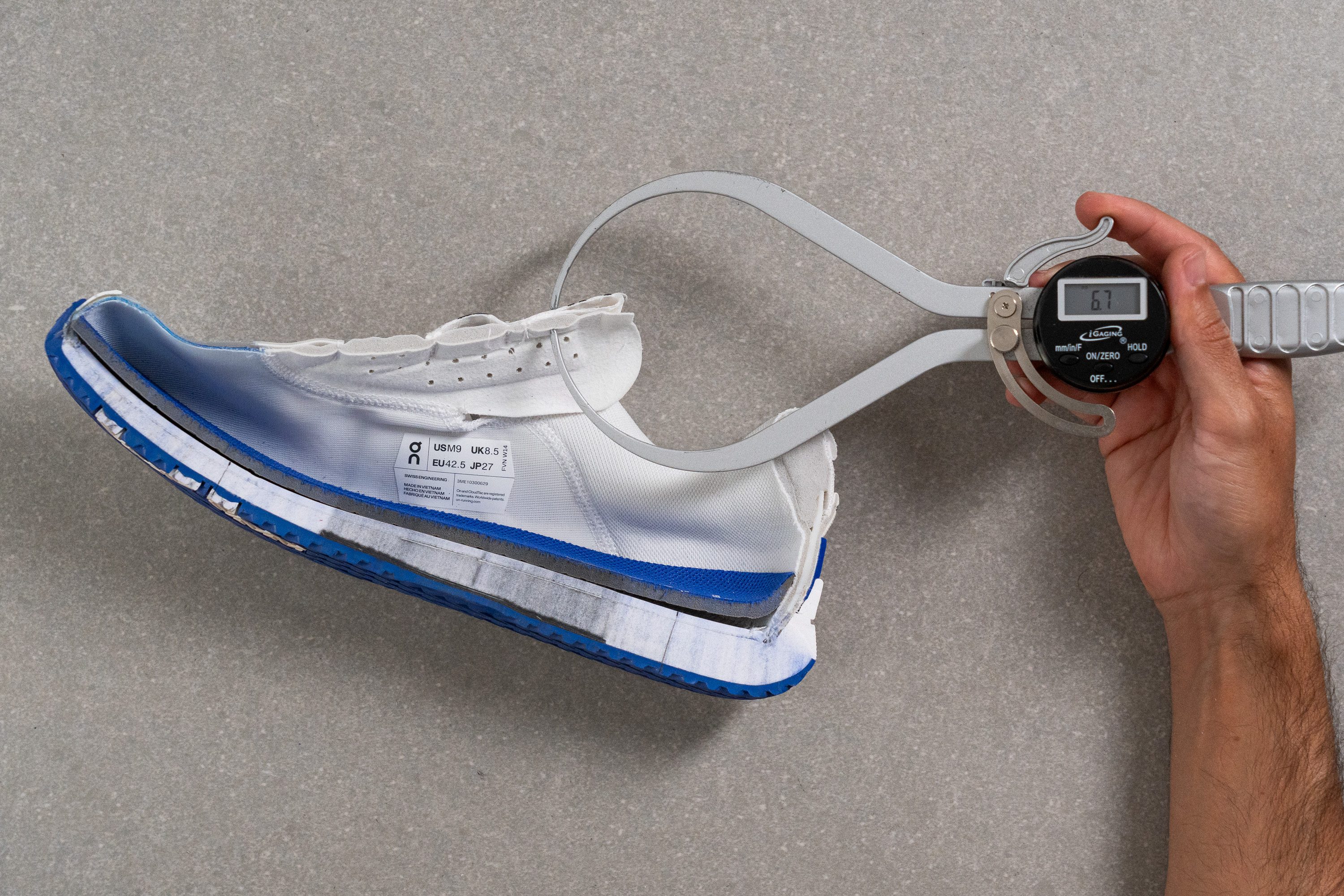
Most of the padding is concentrated in the shoe's collar but, as you can see, the rest of the shoe is pretty minimal and feels more like second skin.
| The ROGER Pro 2 | 6.7 mm |
| Average | 8.1 mm |
Tongue: gusset type
The shoe's midfoot hold is very well taken care of by a semi-gusseted tongue design a.k.a internal half-bootie construction.
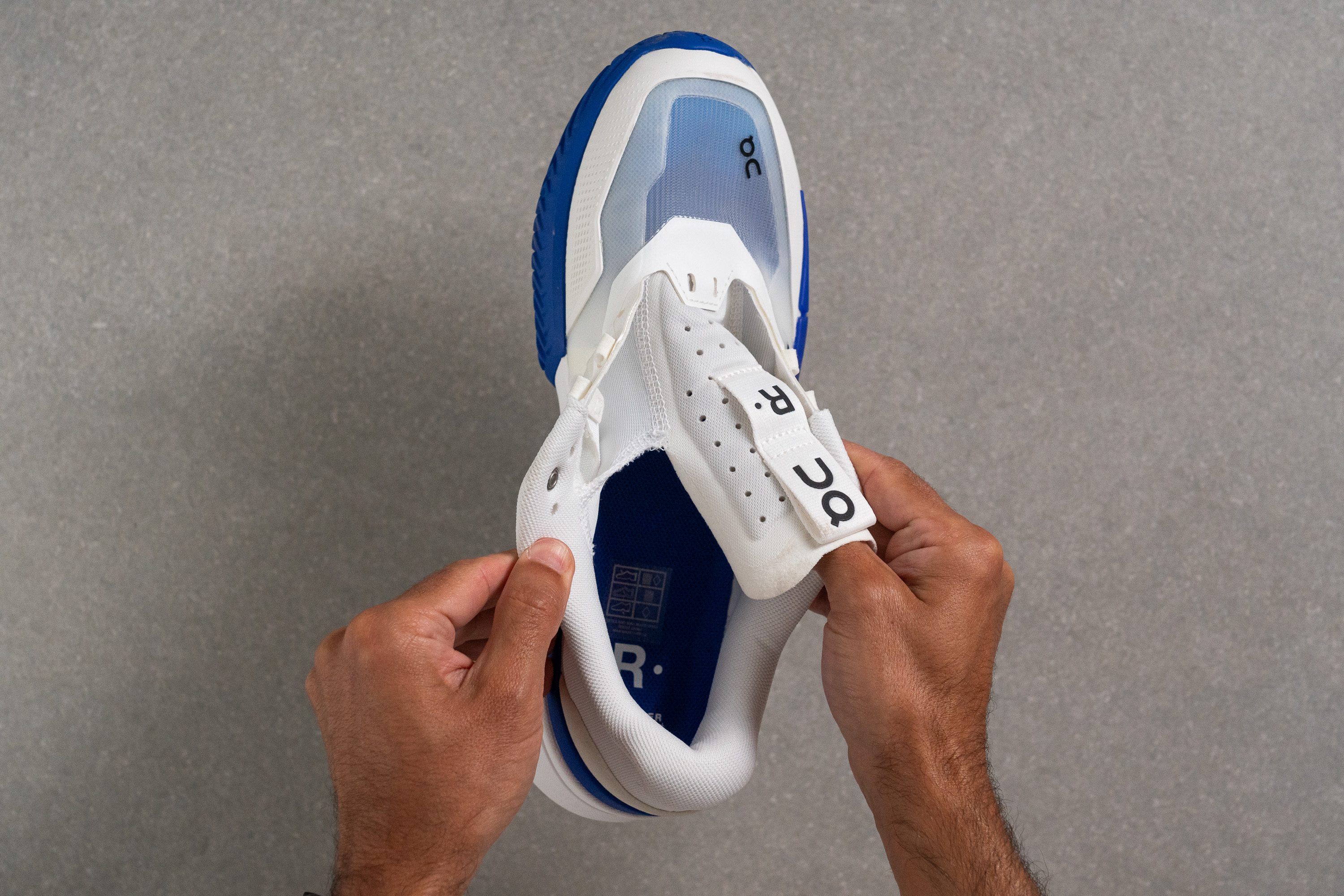
We didn't have to worry about tongue sliding or foot twisting inside the shoe thanks to its secure hold.
| The ROGER Pro 2 | Both sides (semi) |
Price
We believe that the asking price of the On The Roger Pro 2 is too high. Even though this tennis shoe has many advantages, we don't think it justifies paying a lot more than the average price.
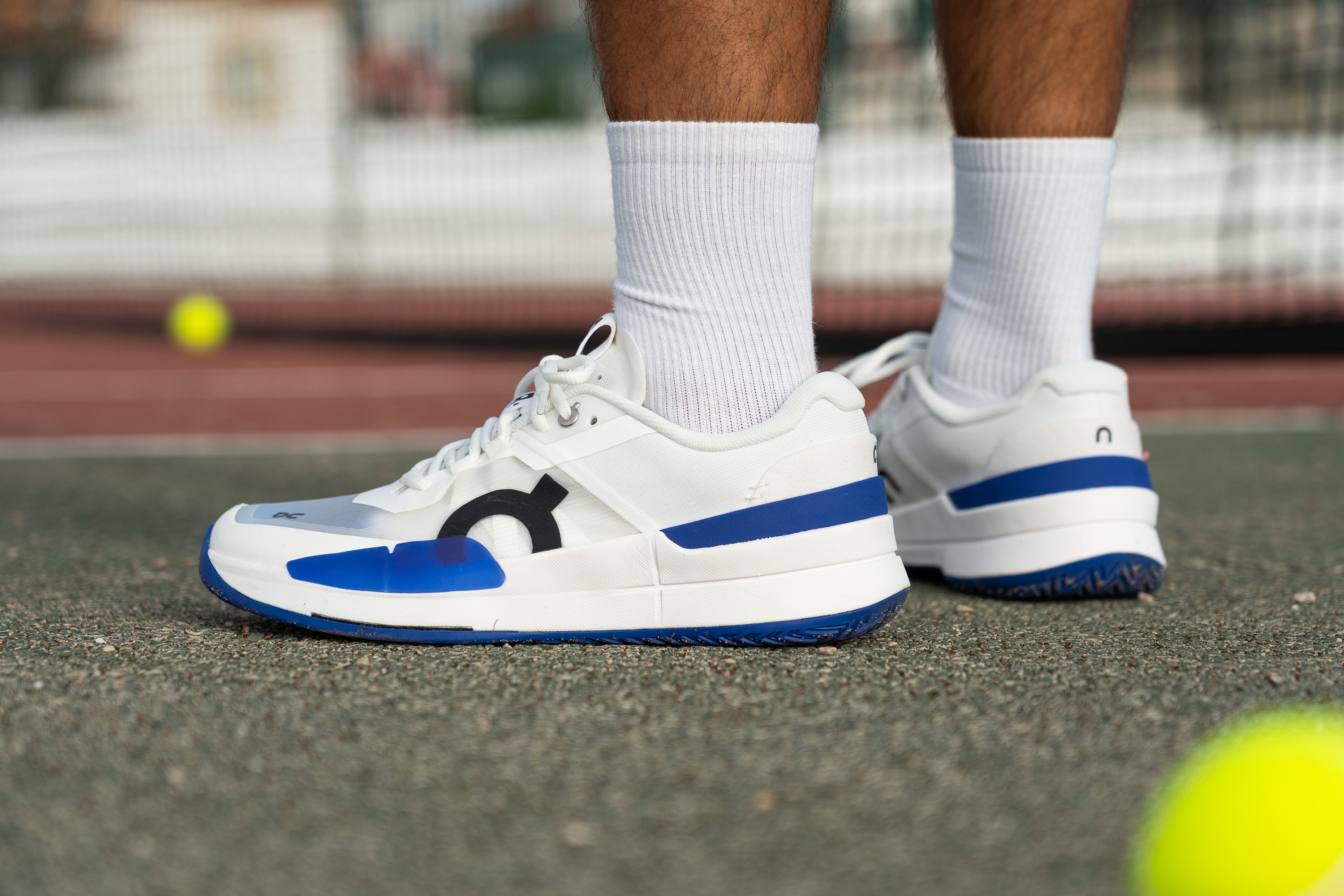
It seems like On forces you to pay more for the brand name, the reference to Roger Federer, and the visual appeal that stands out from a typical tennis shoe look.
Having thoroughly tested dozens of tennis shoes, we found that some of the best-performing tennis shoes on the market are priced much more reasonably.
| The ROGER Pro 2 | $200 |
| Average | $132 |
Heel tab
The absence of finger loops and pull tabs wasn't a problem thanks to the structured heel counter which made it easy to slide into the shoe.

| The ROGER Pro 2 | None |

